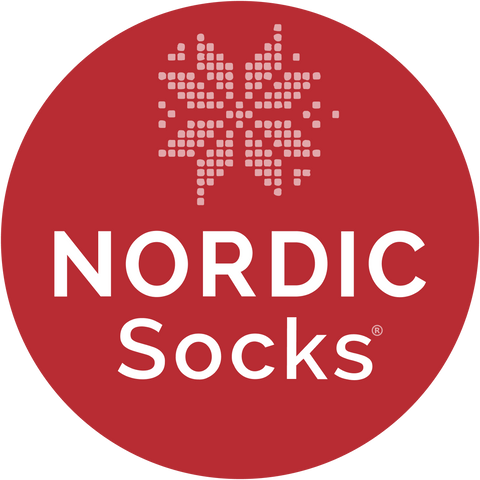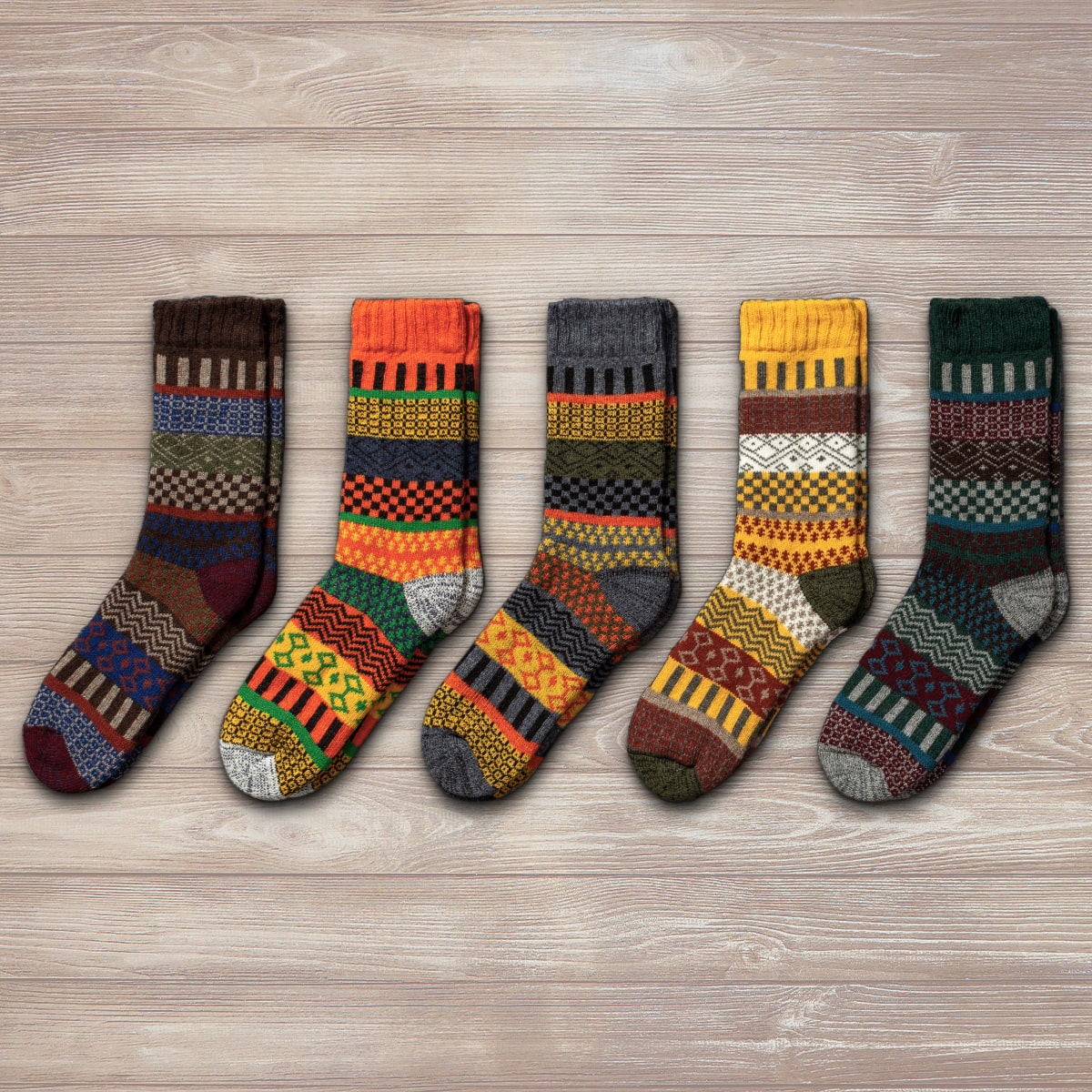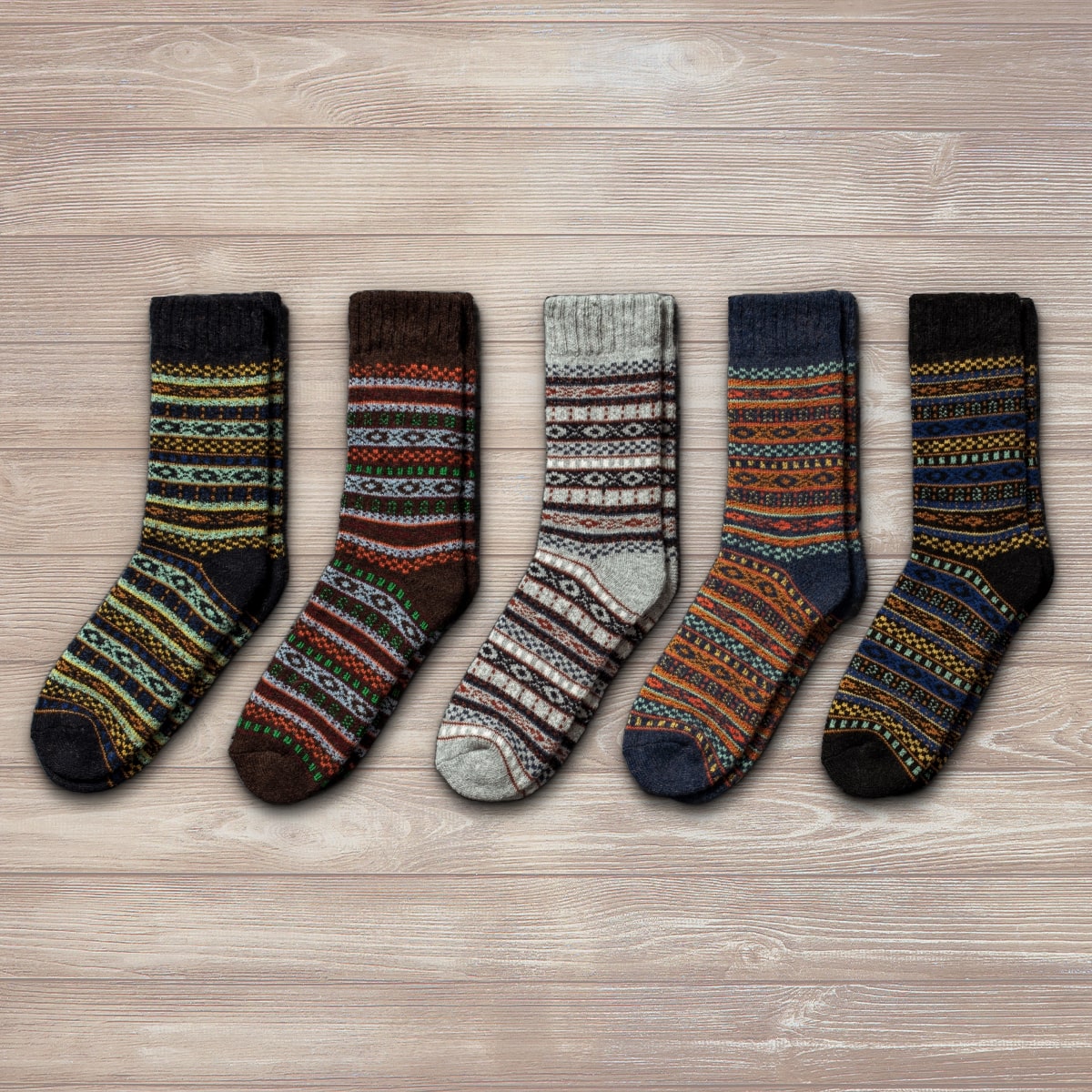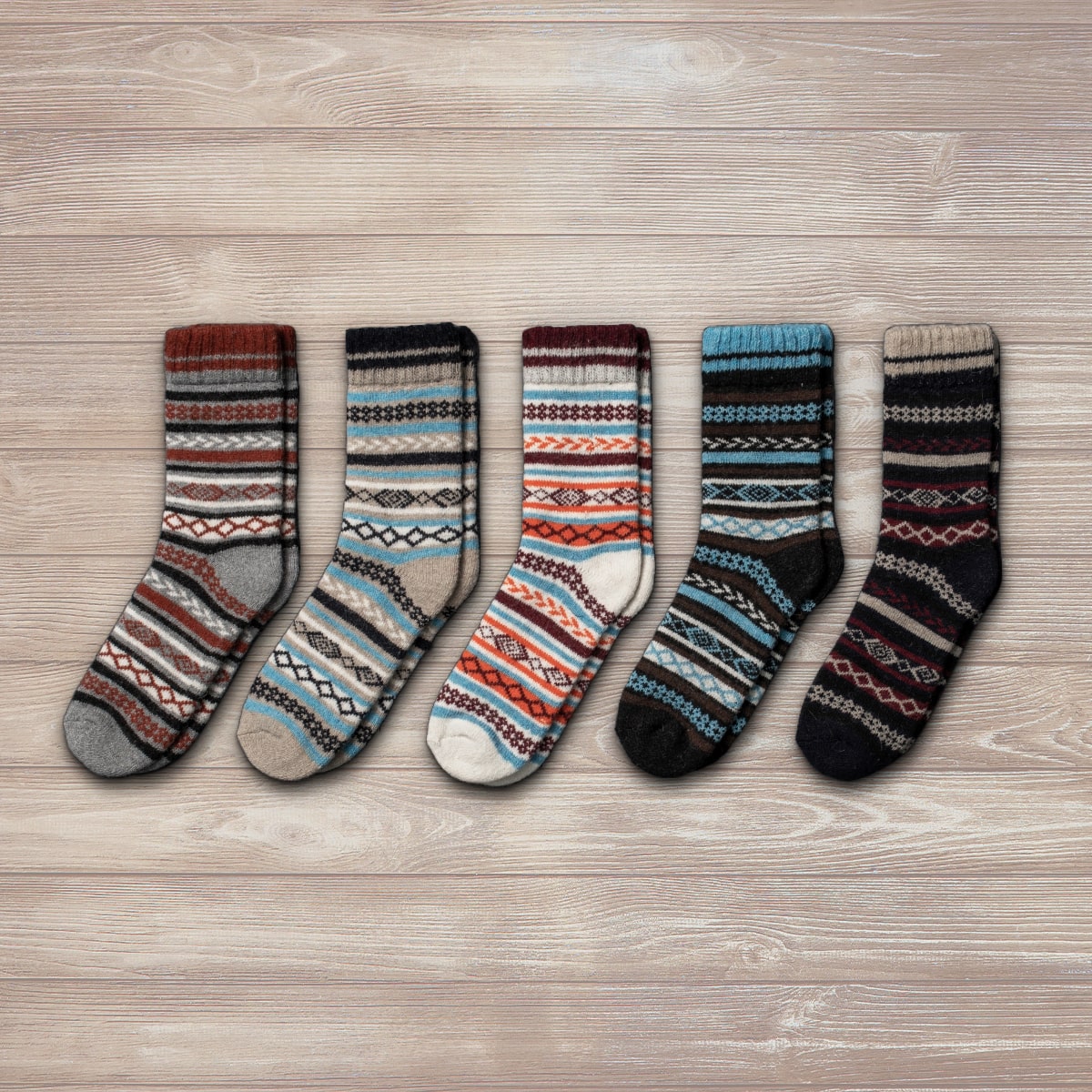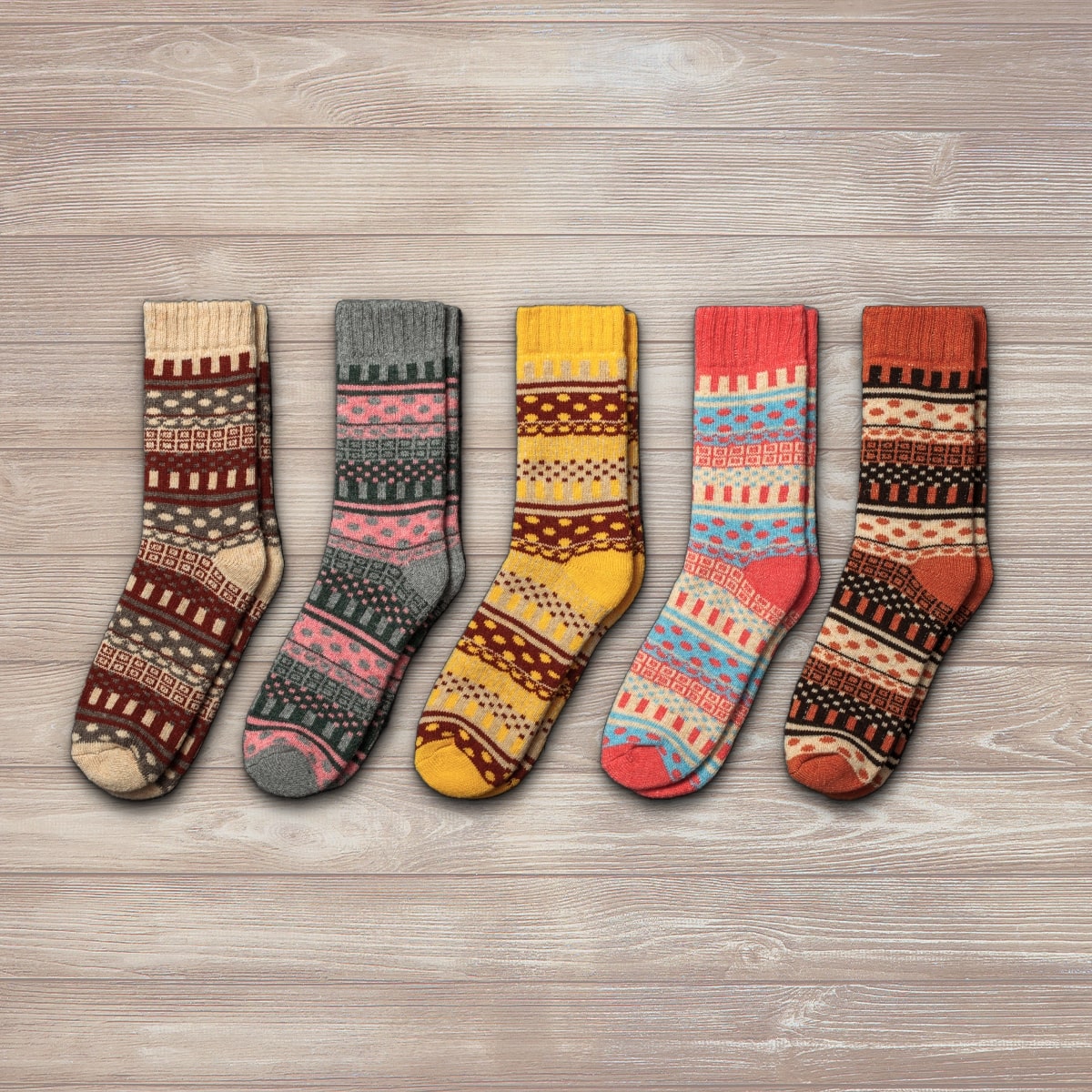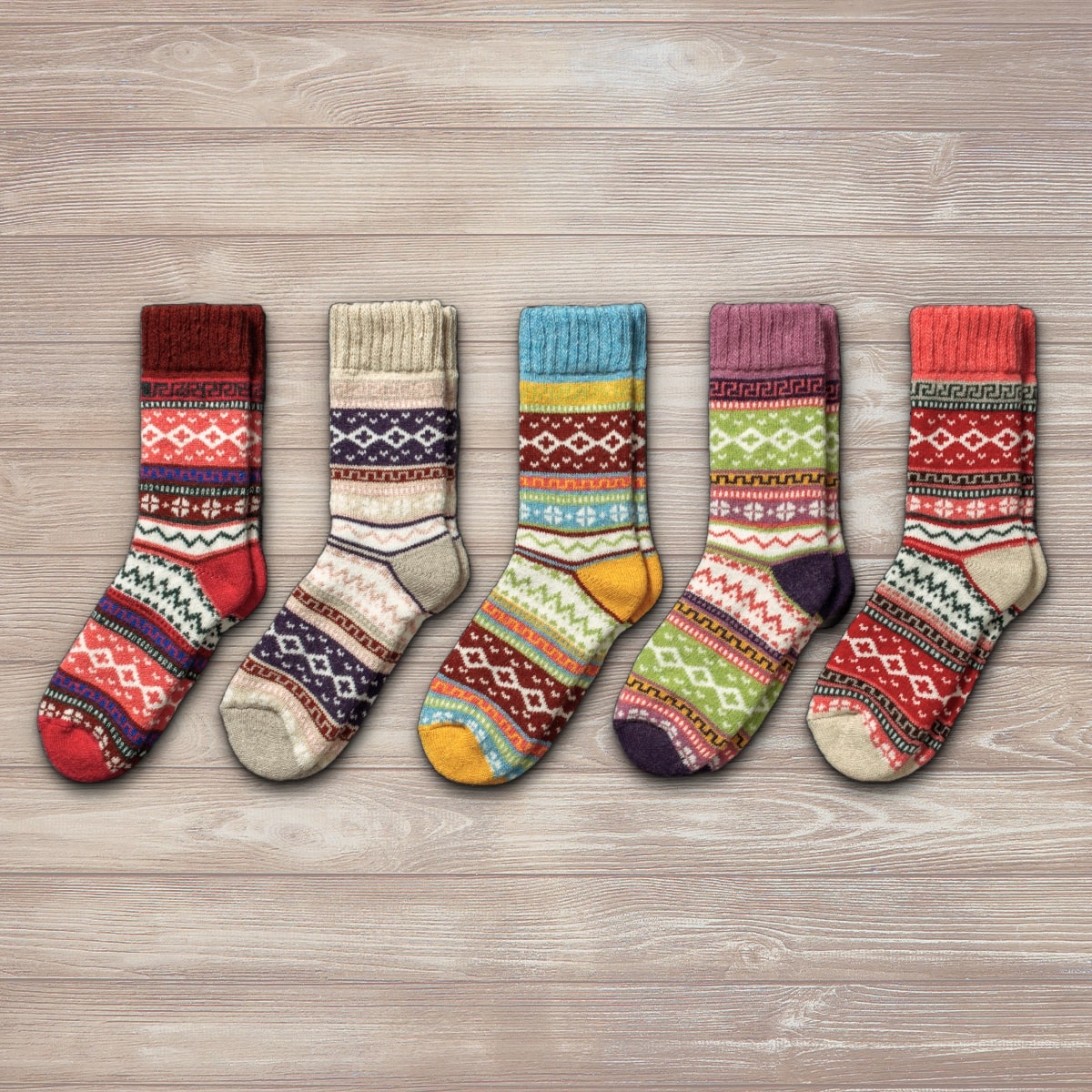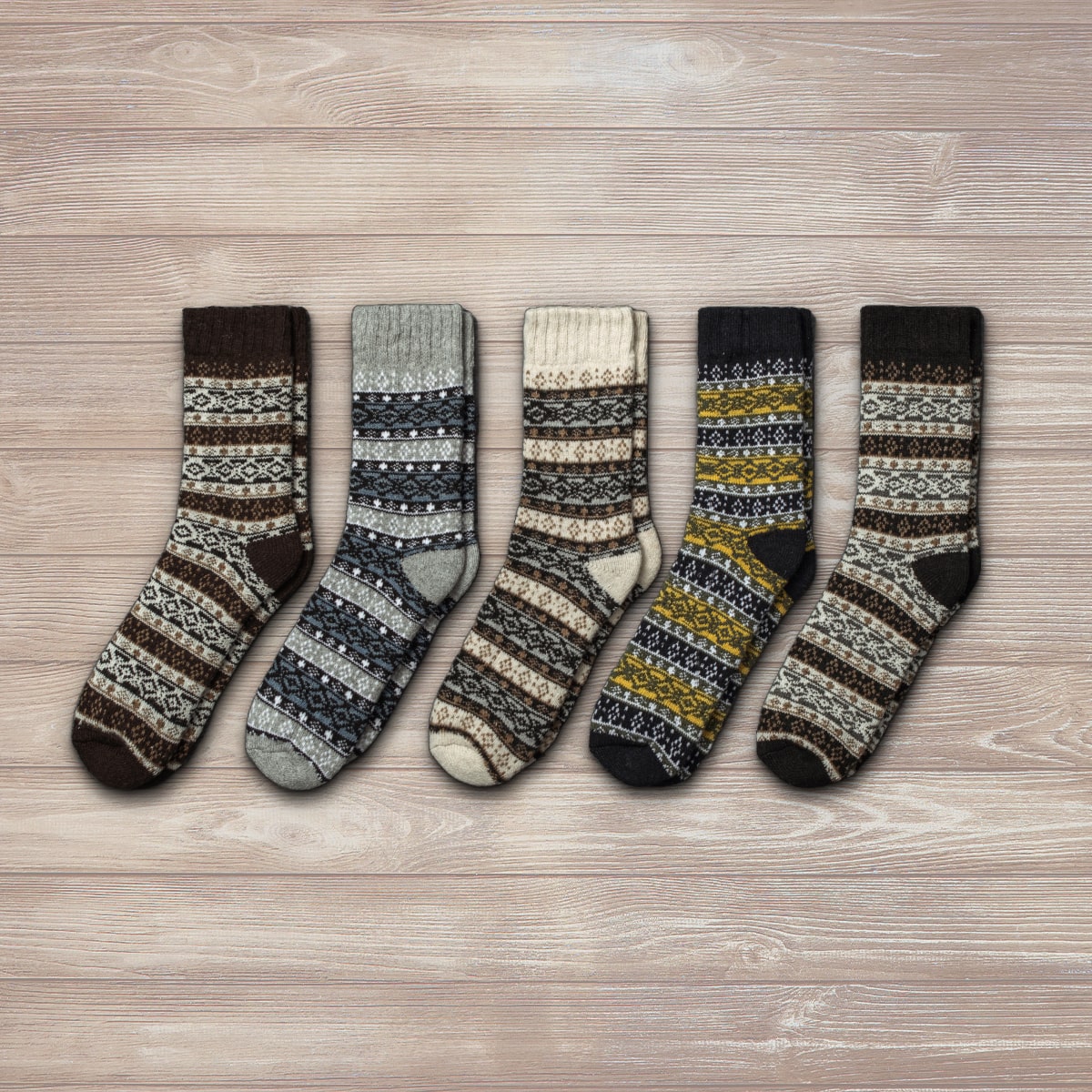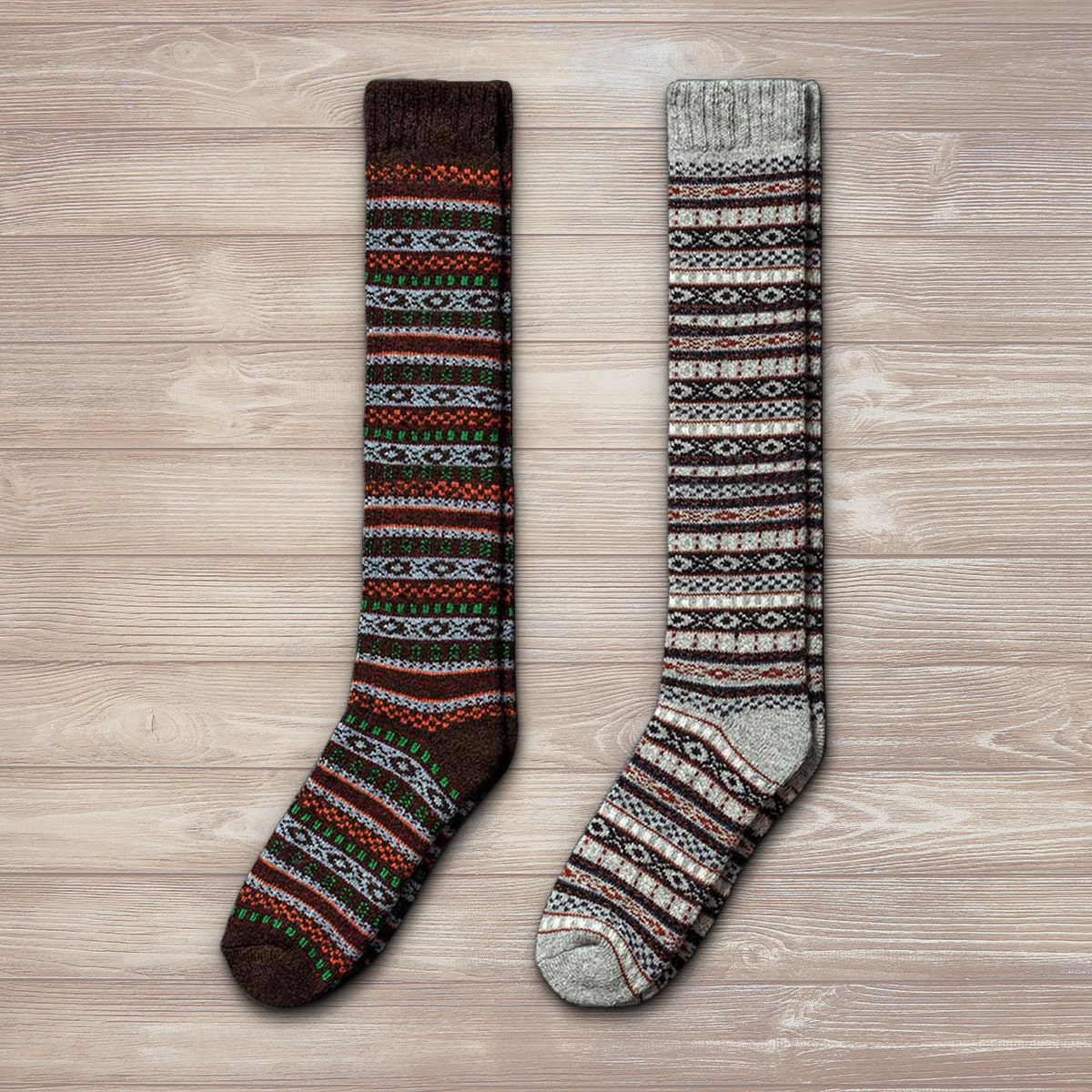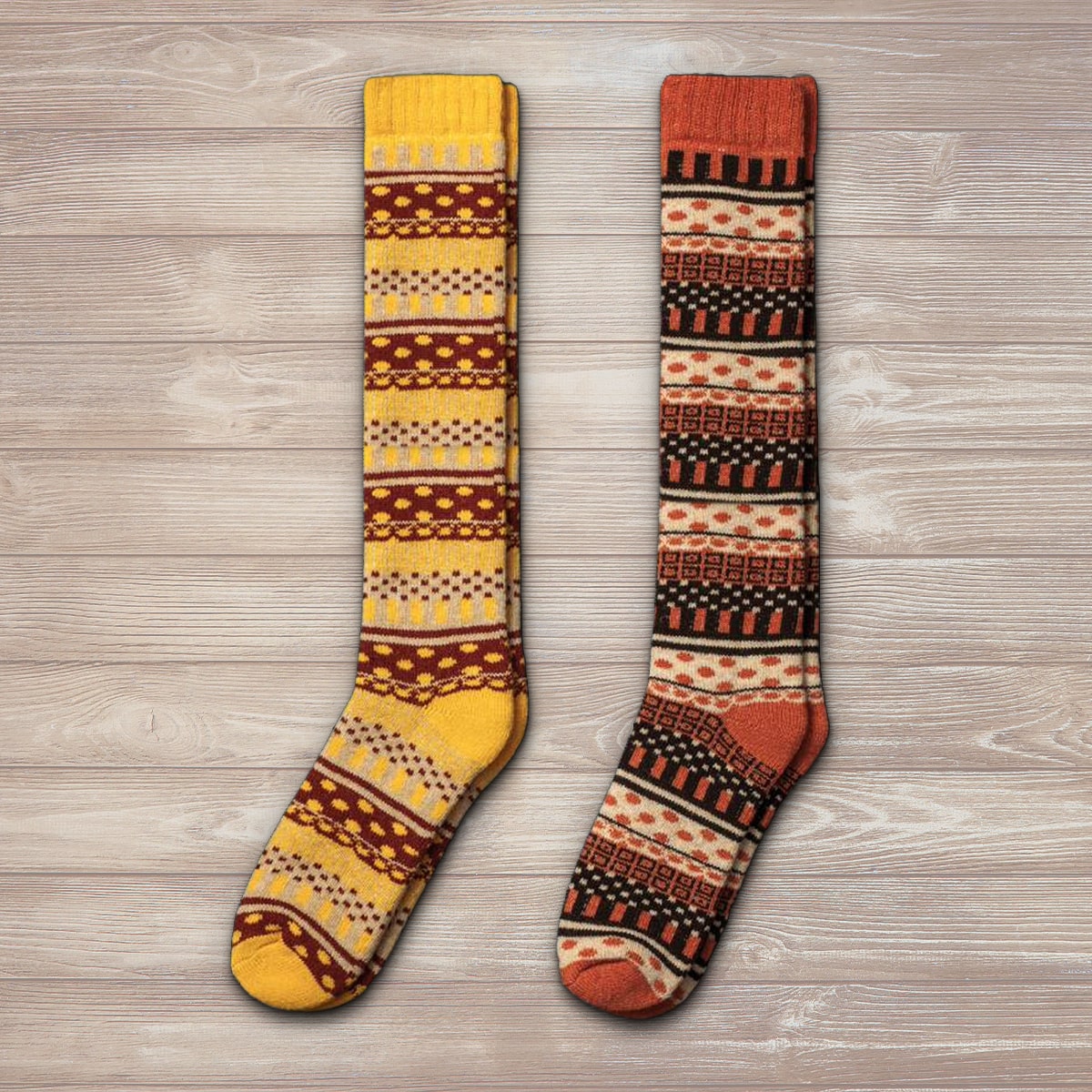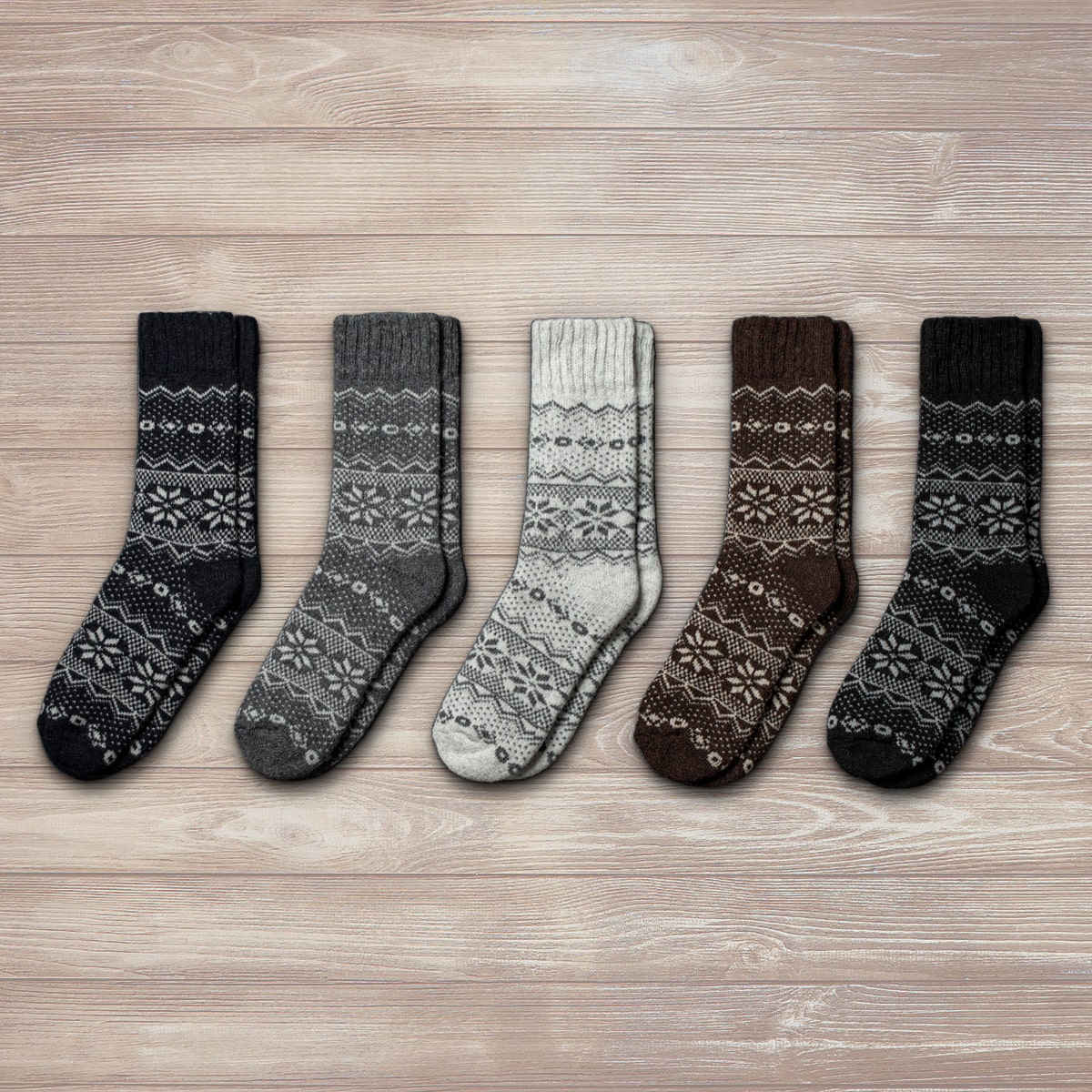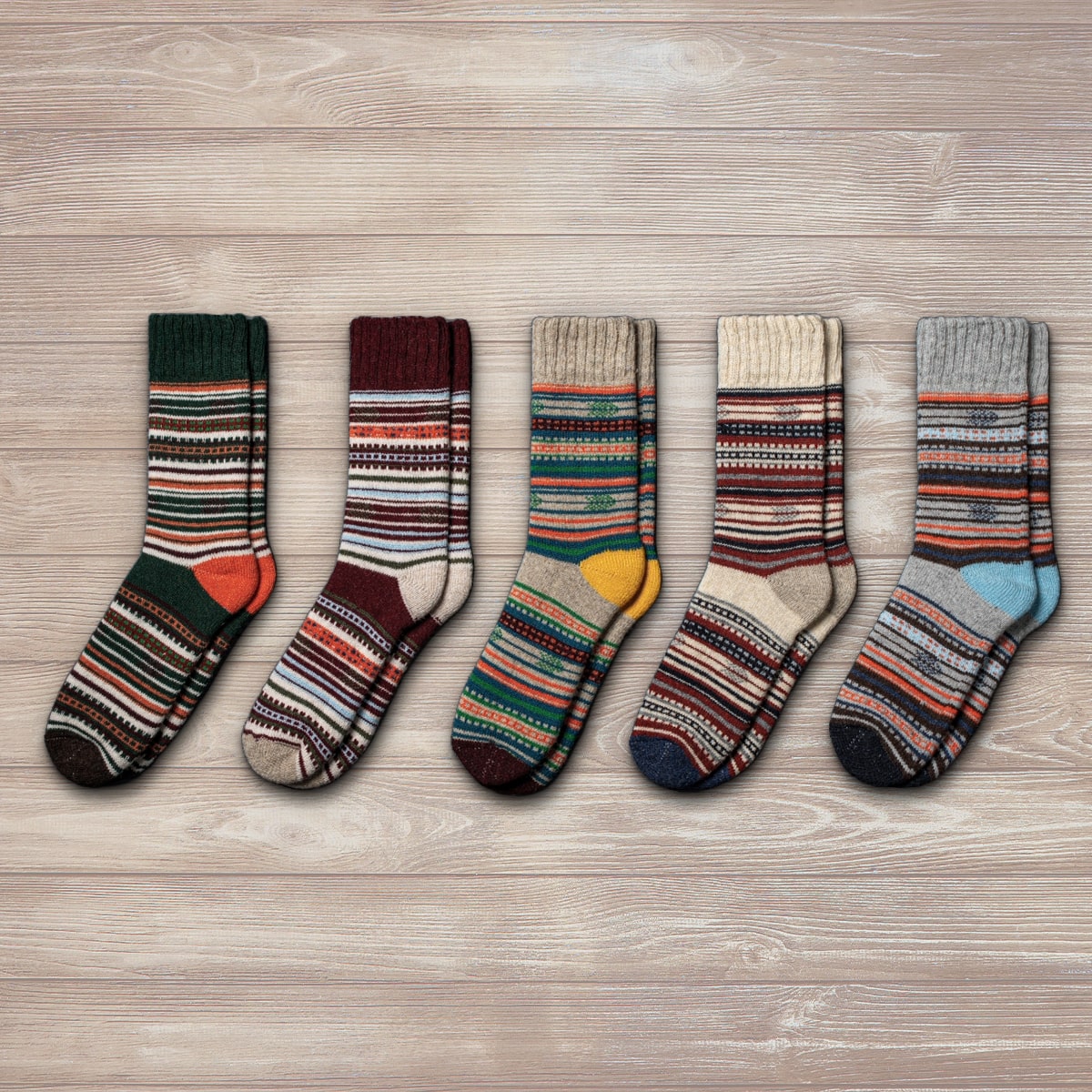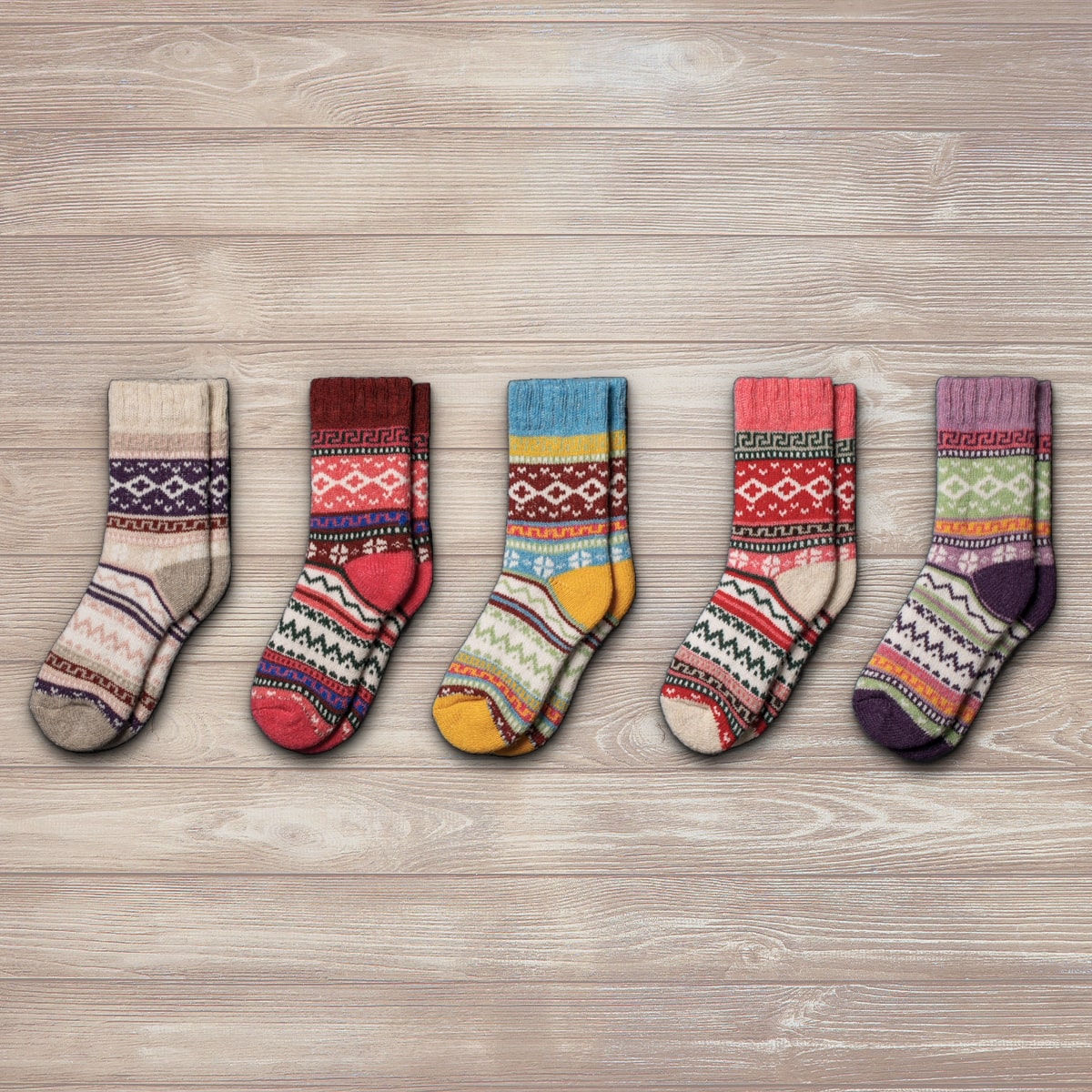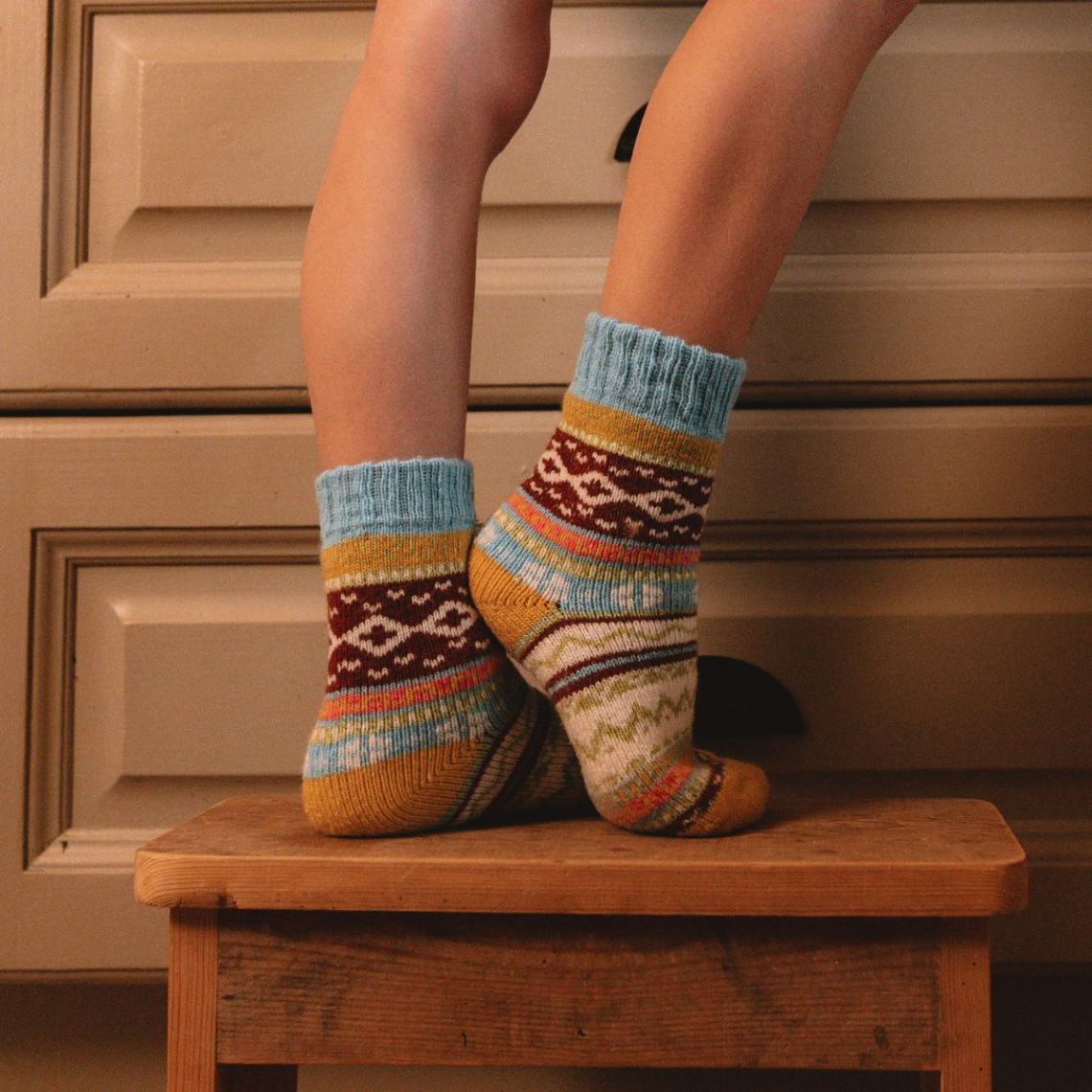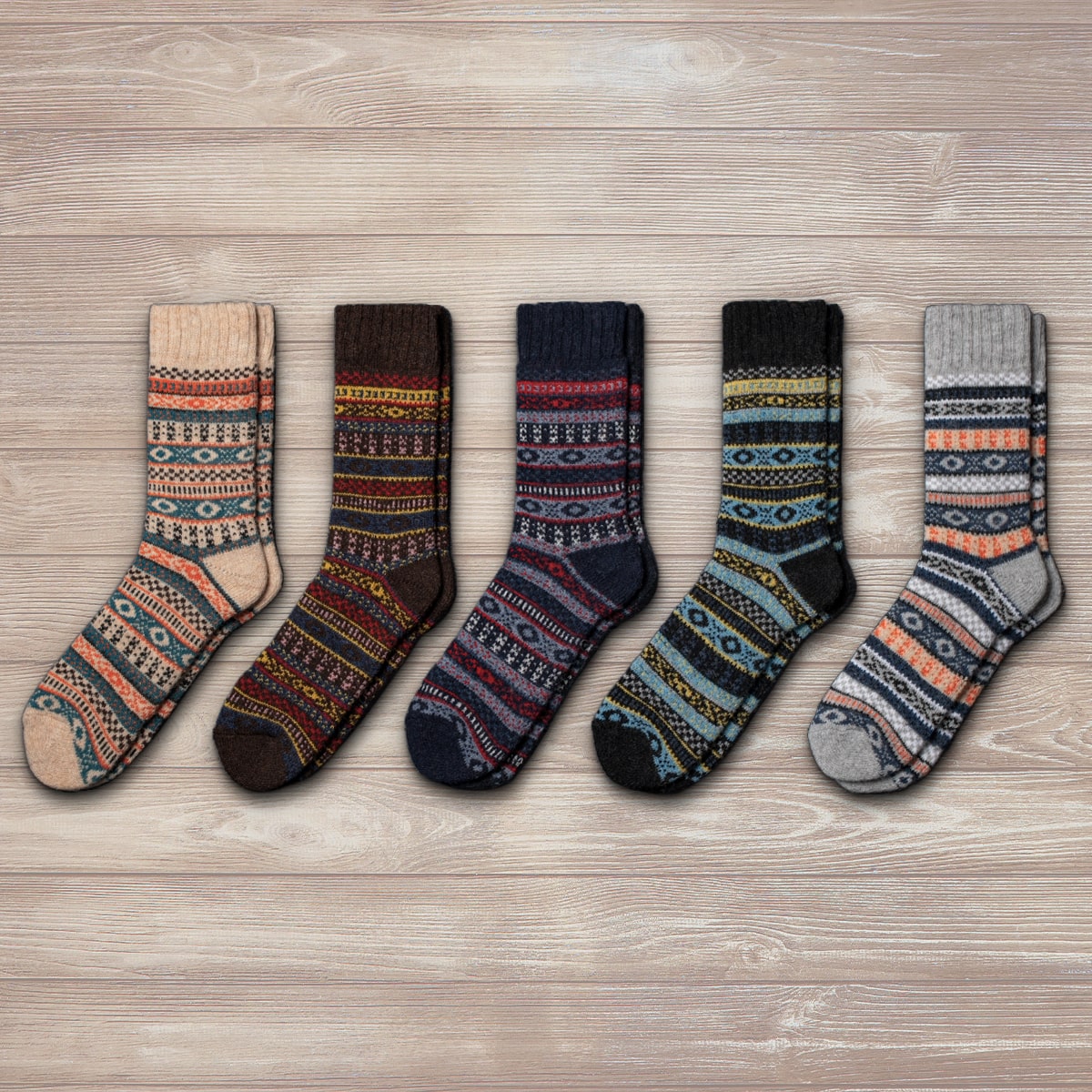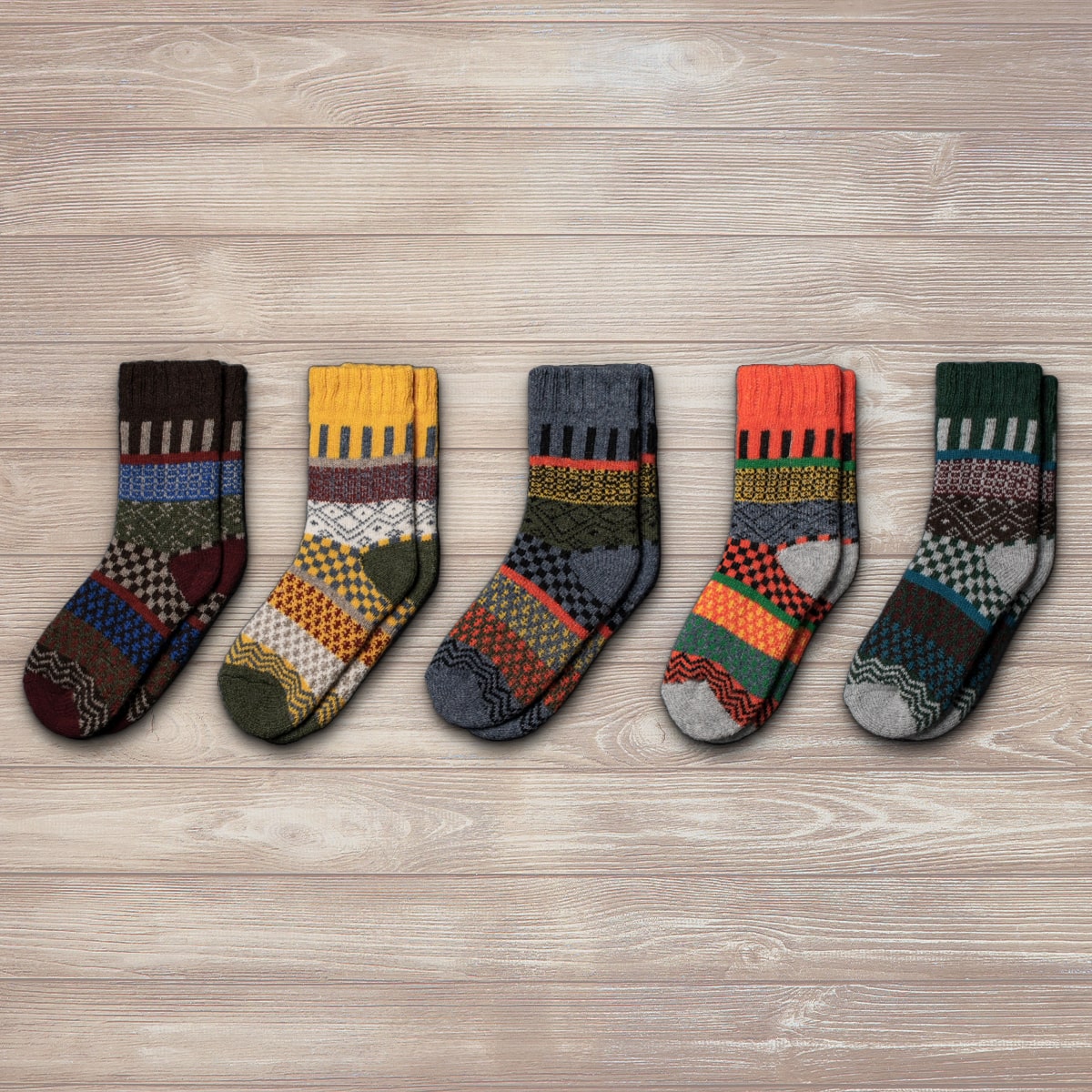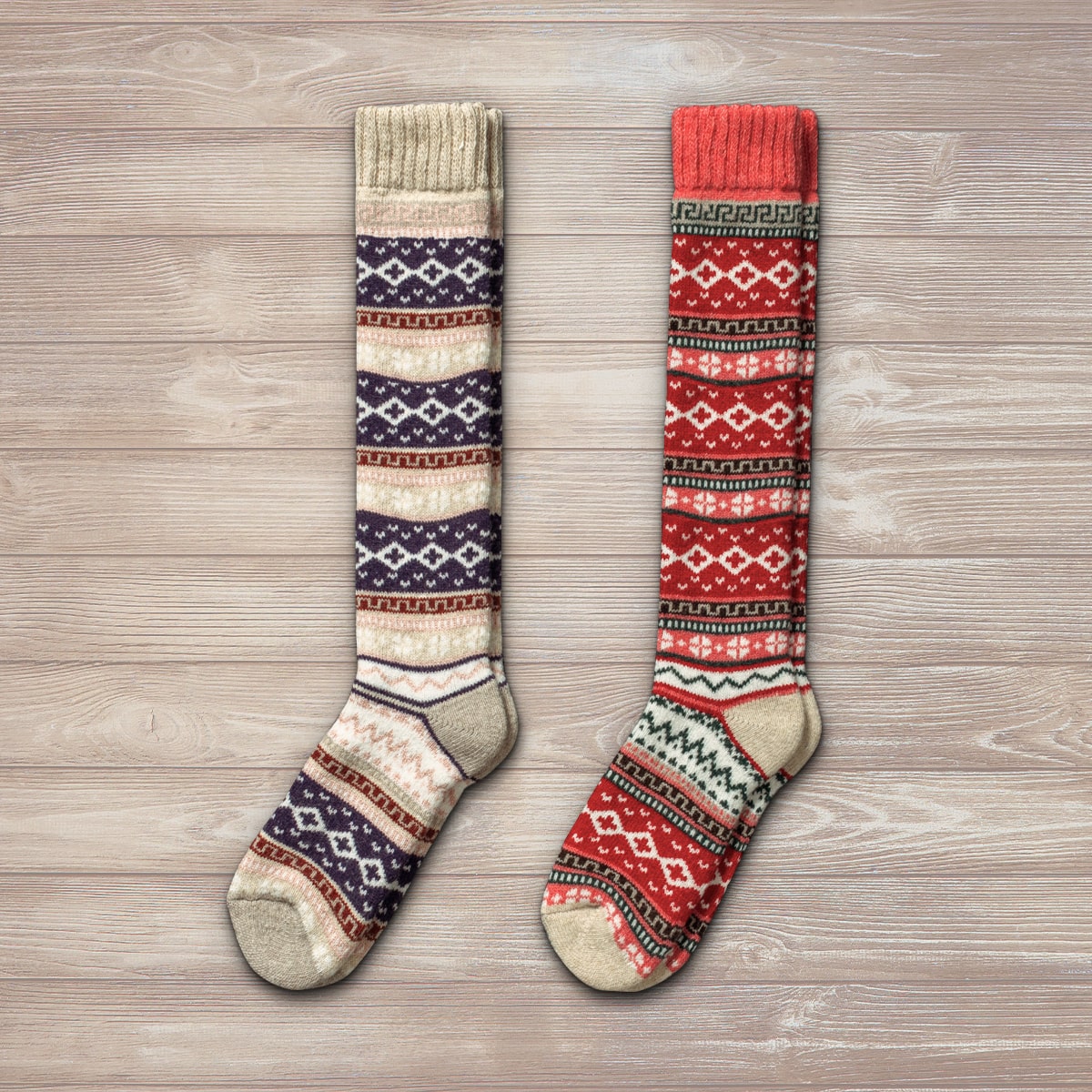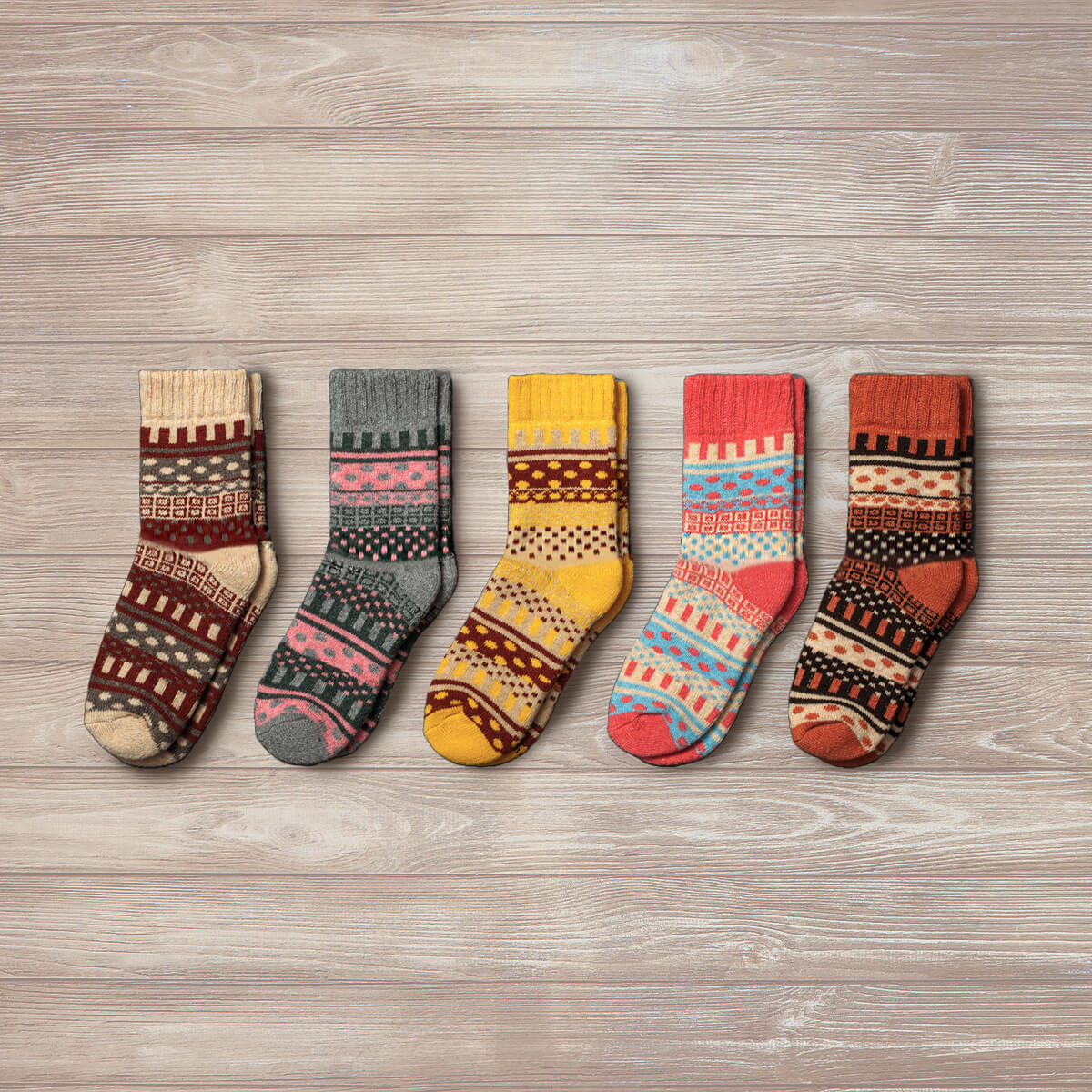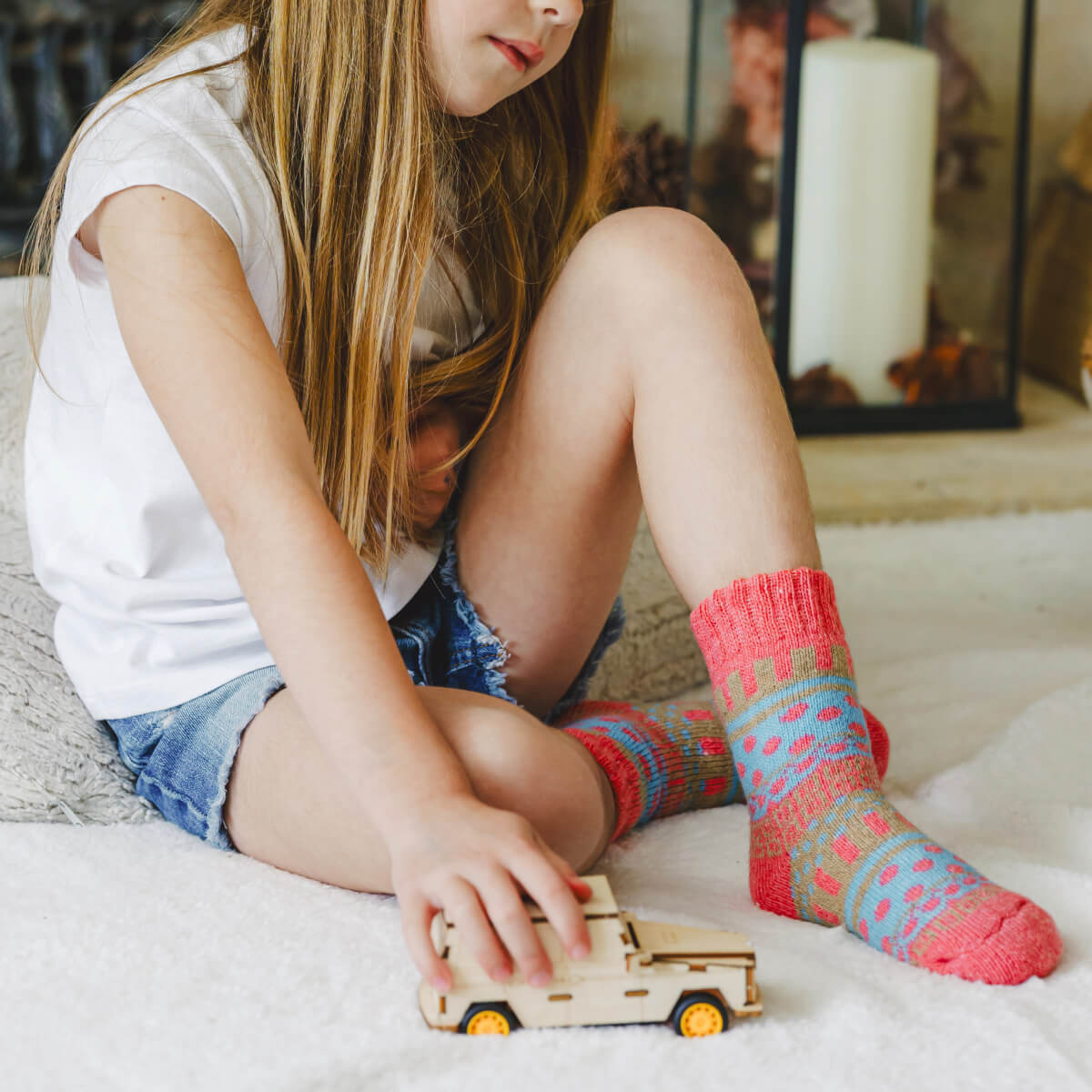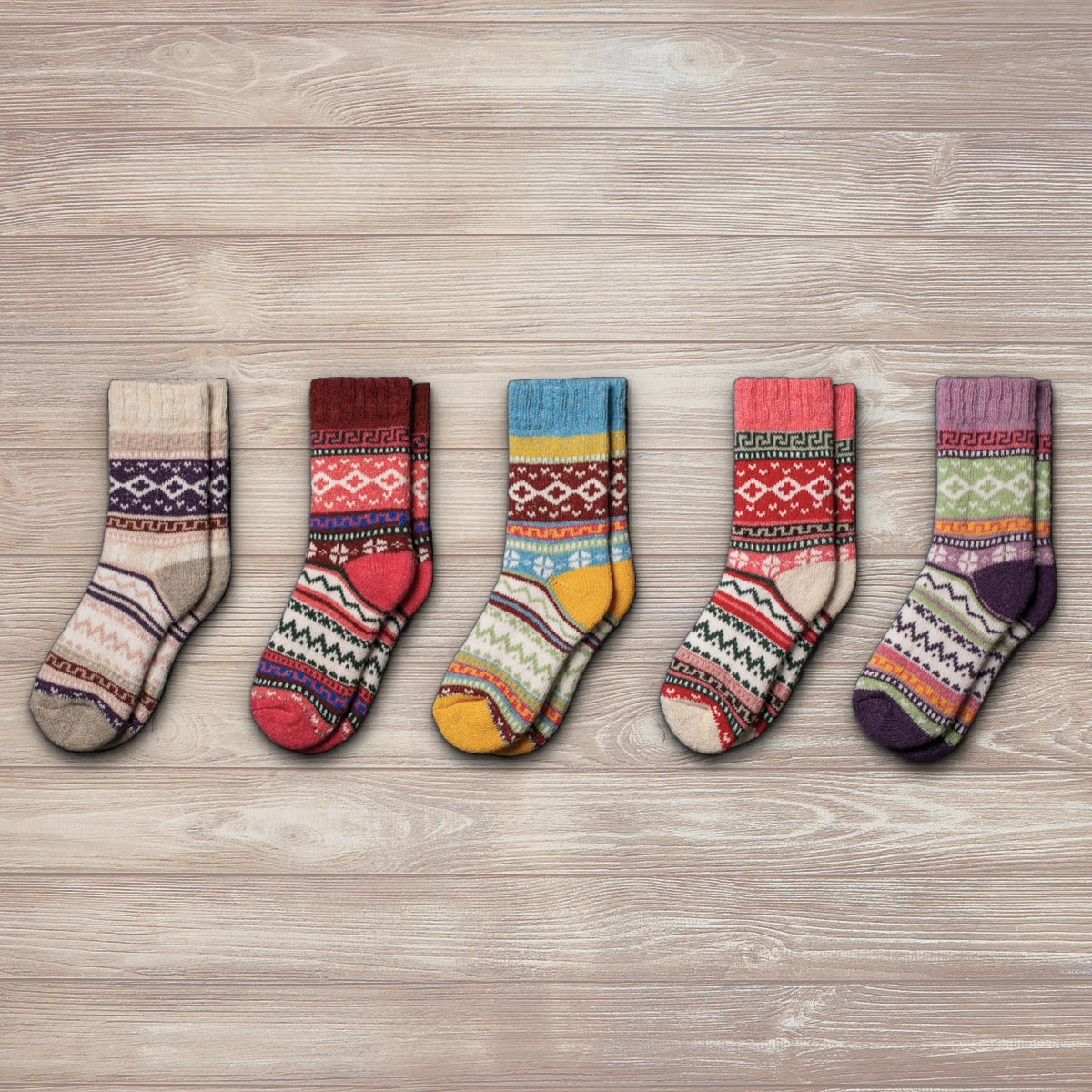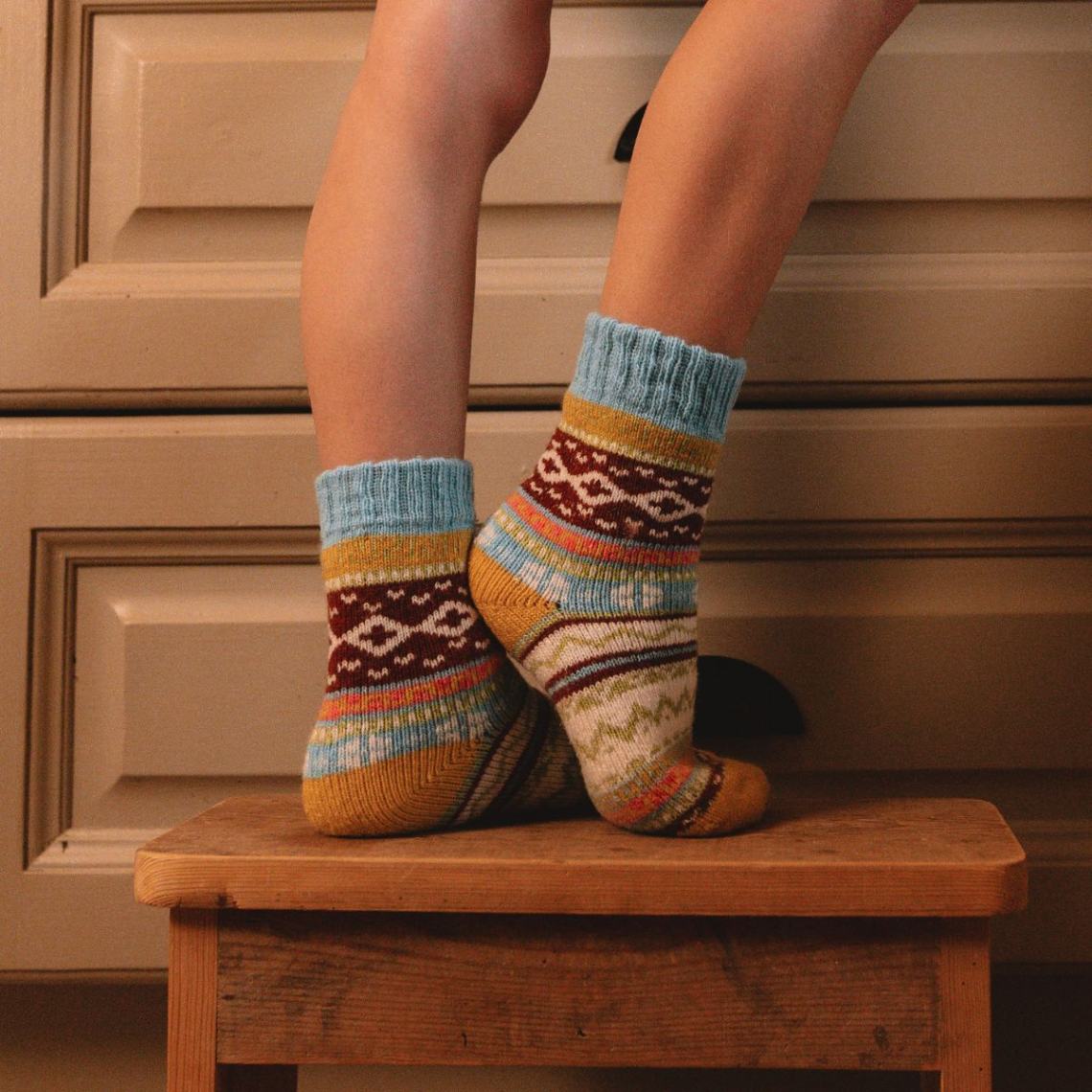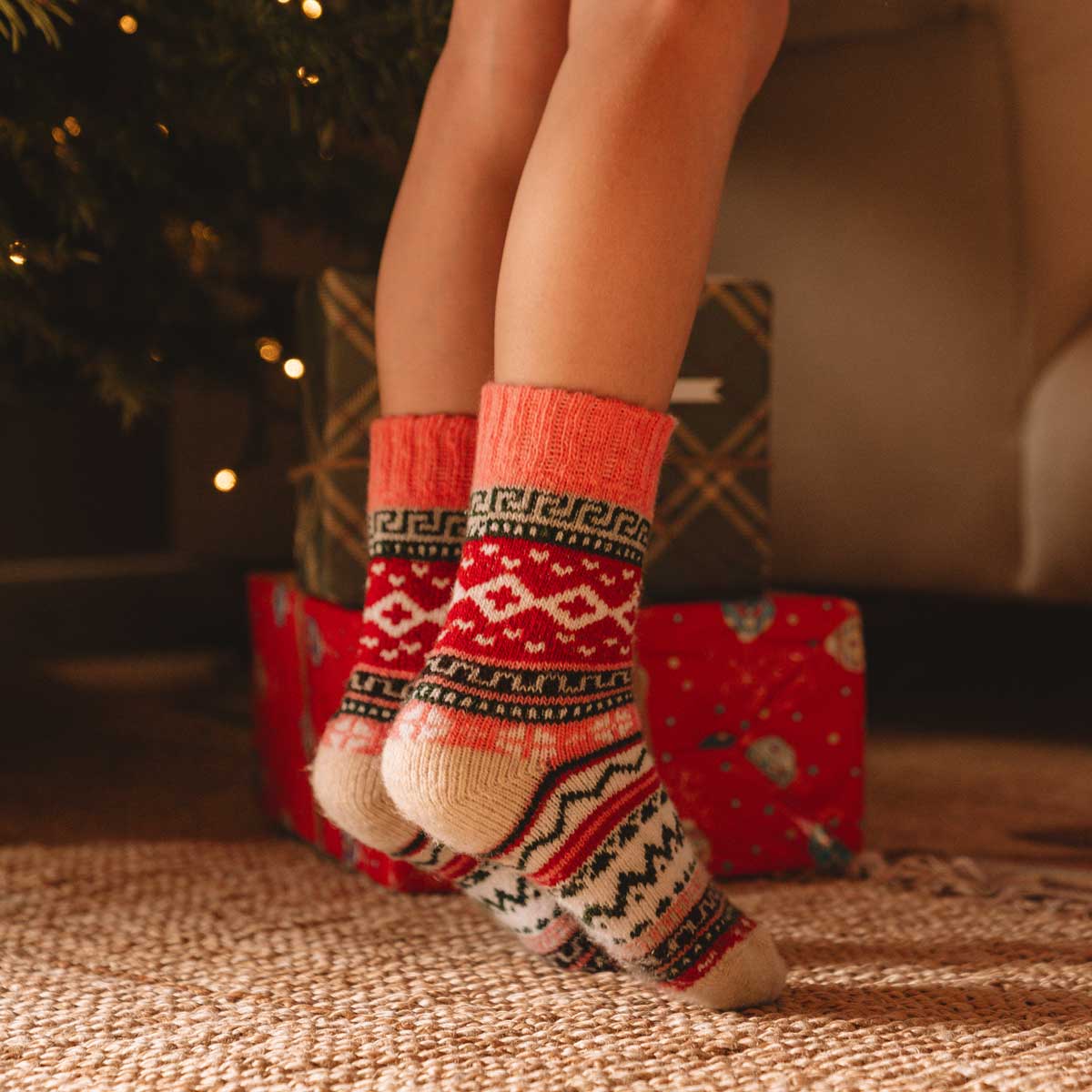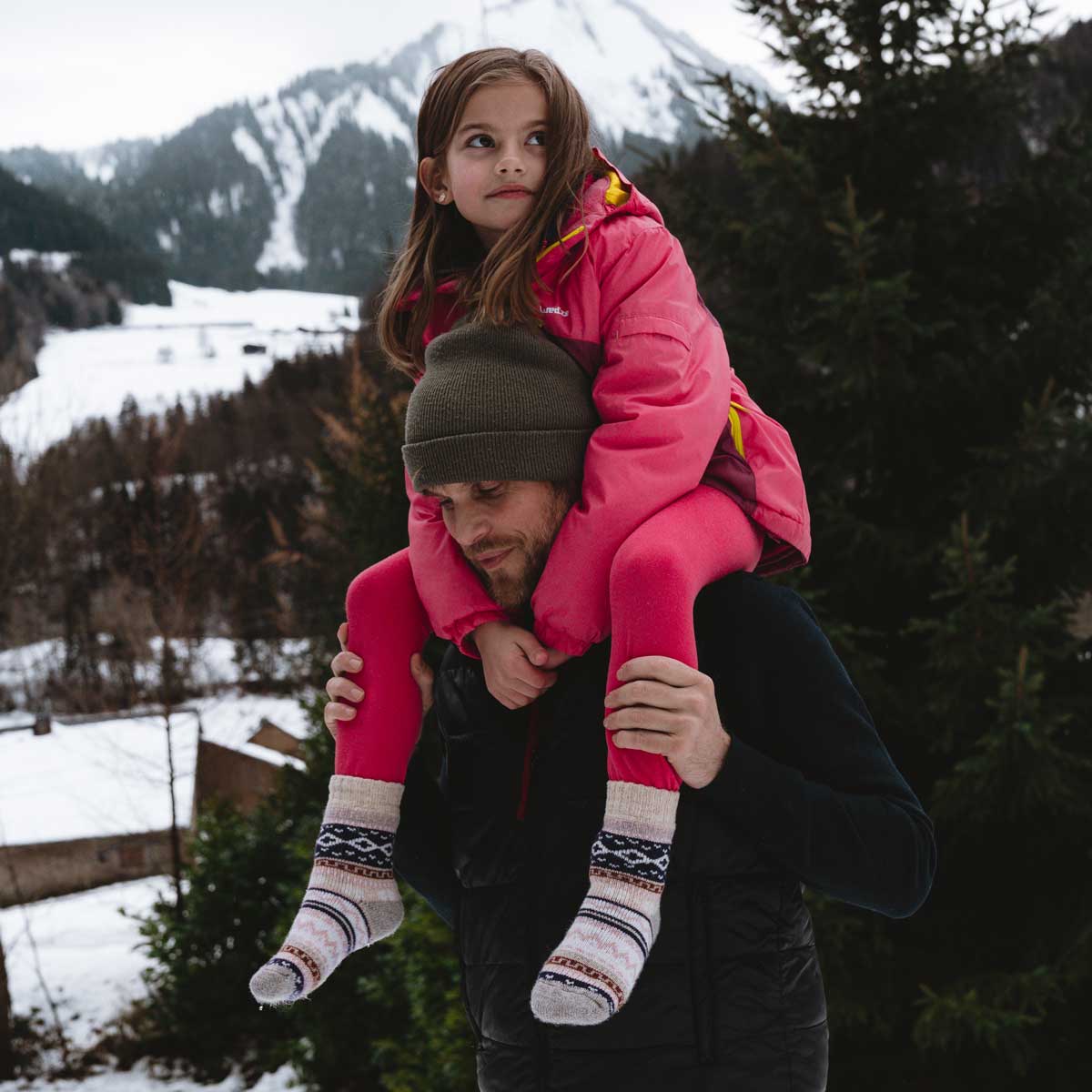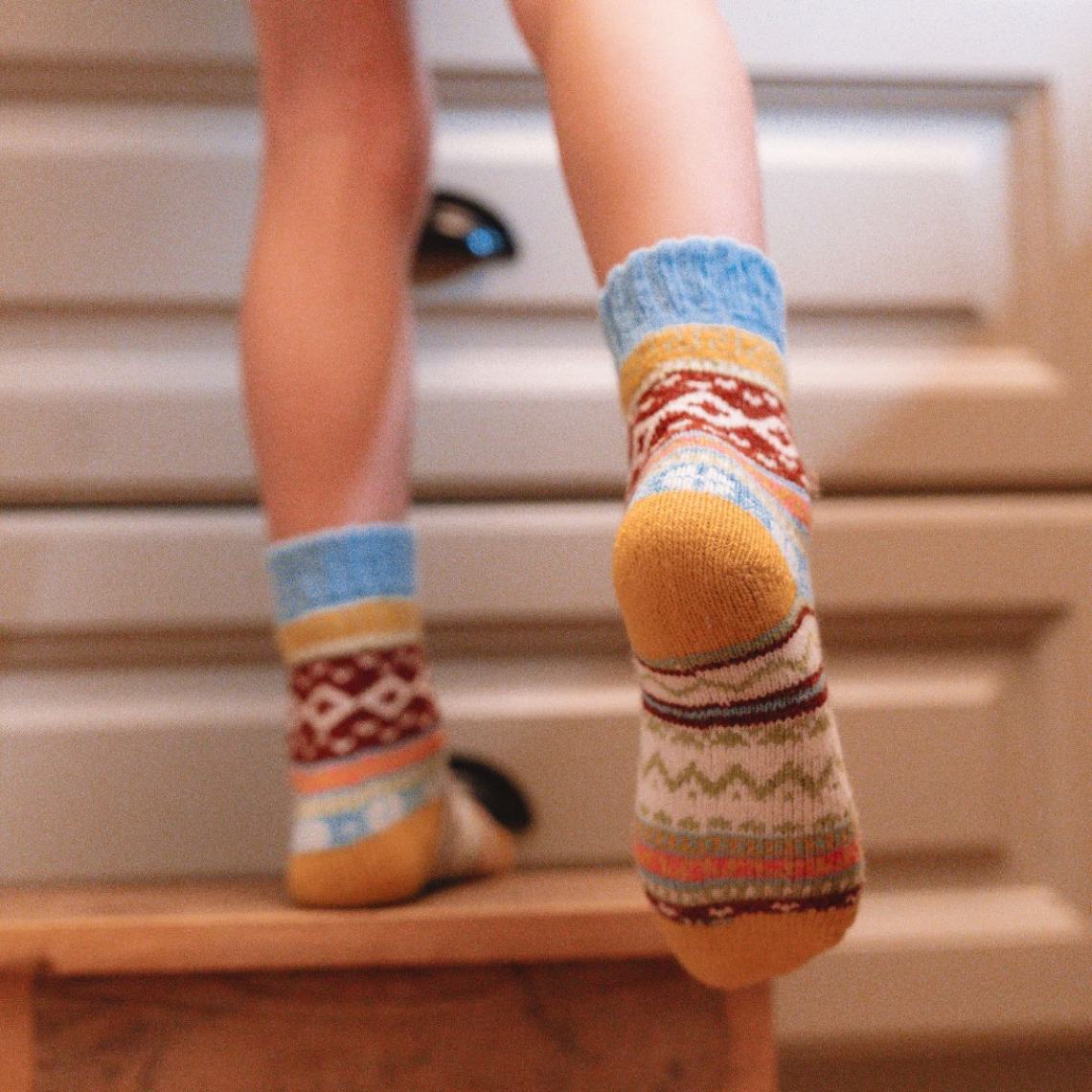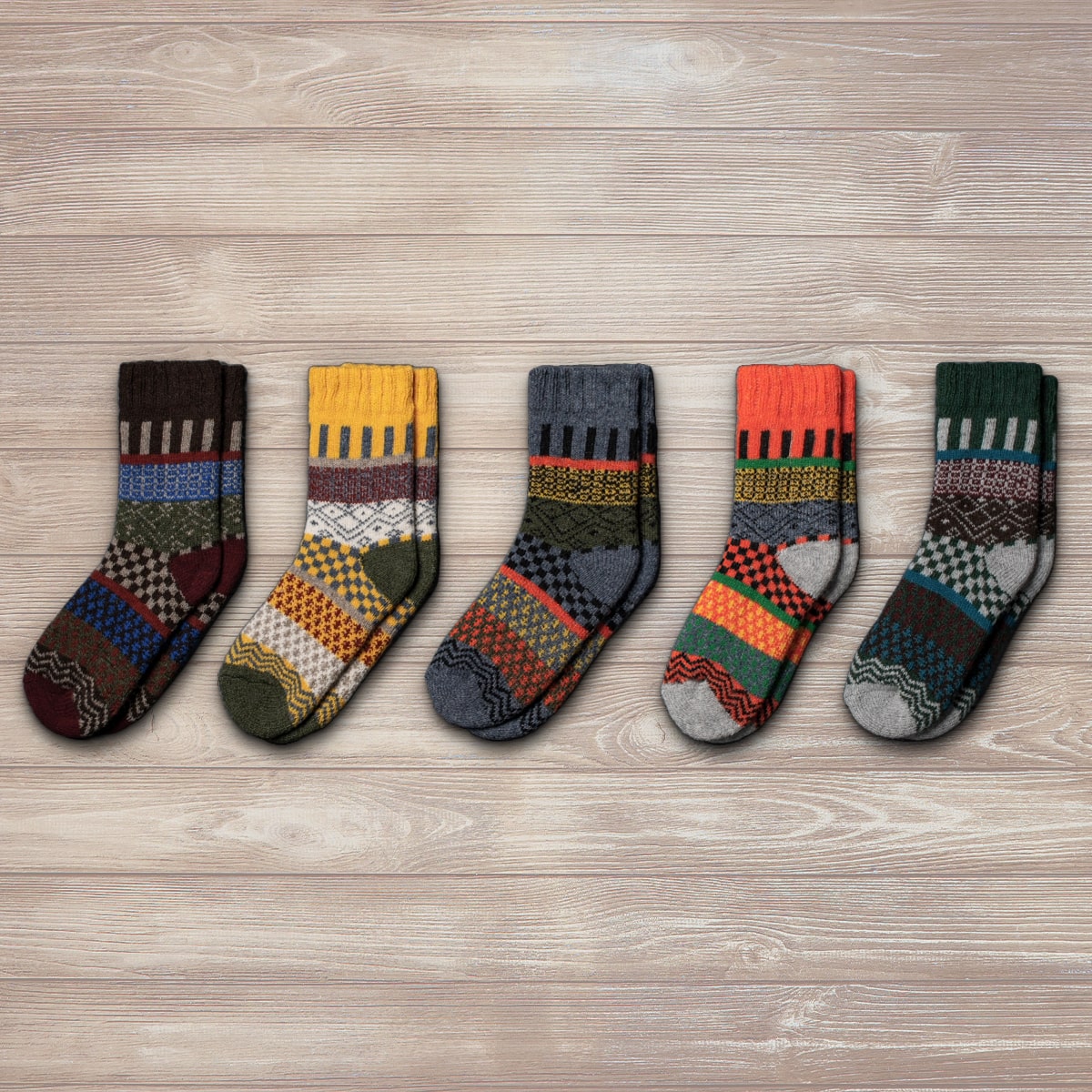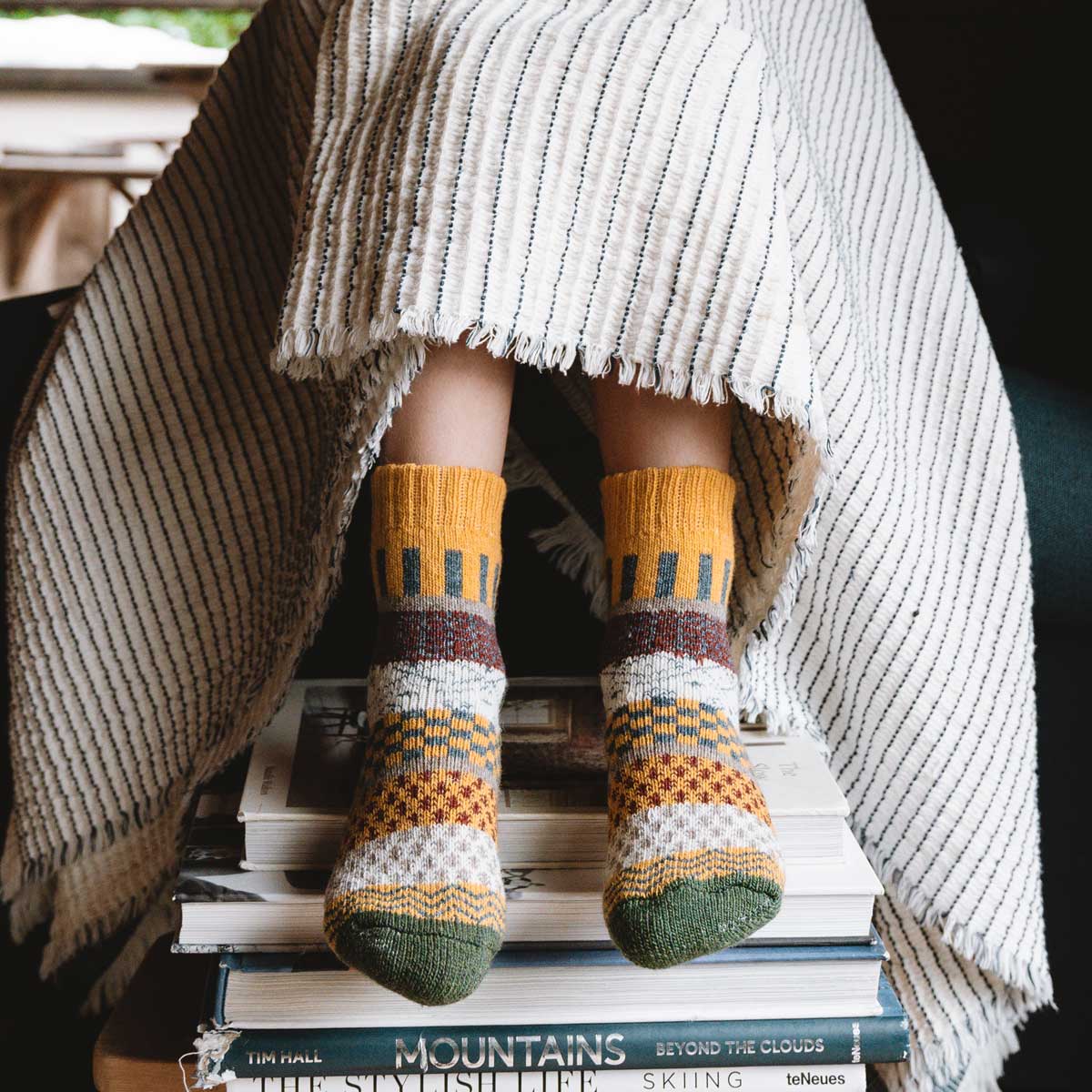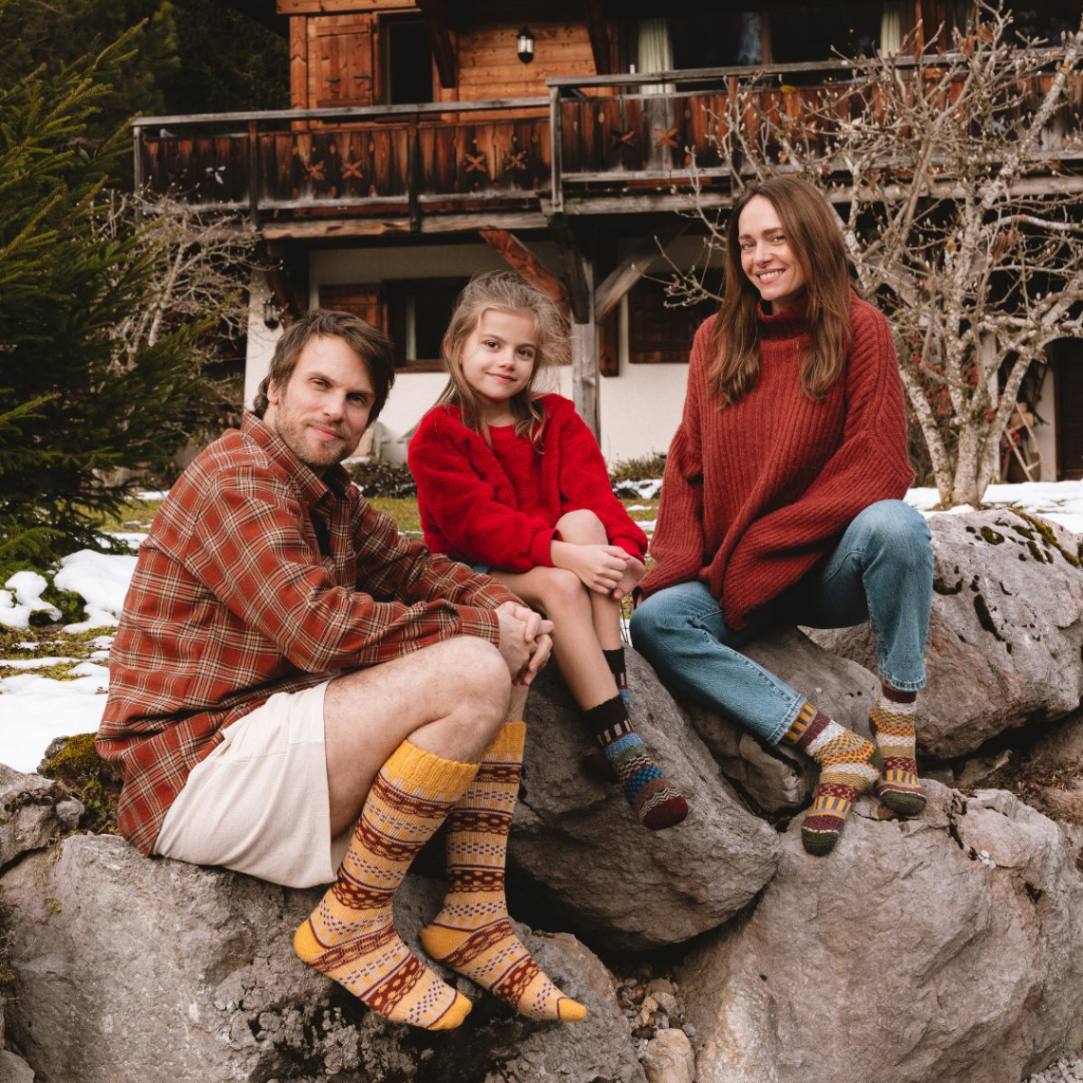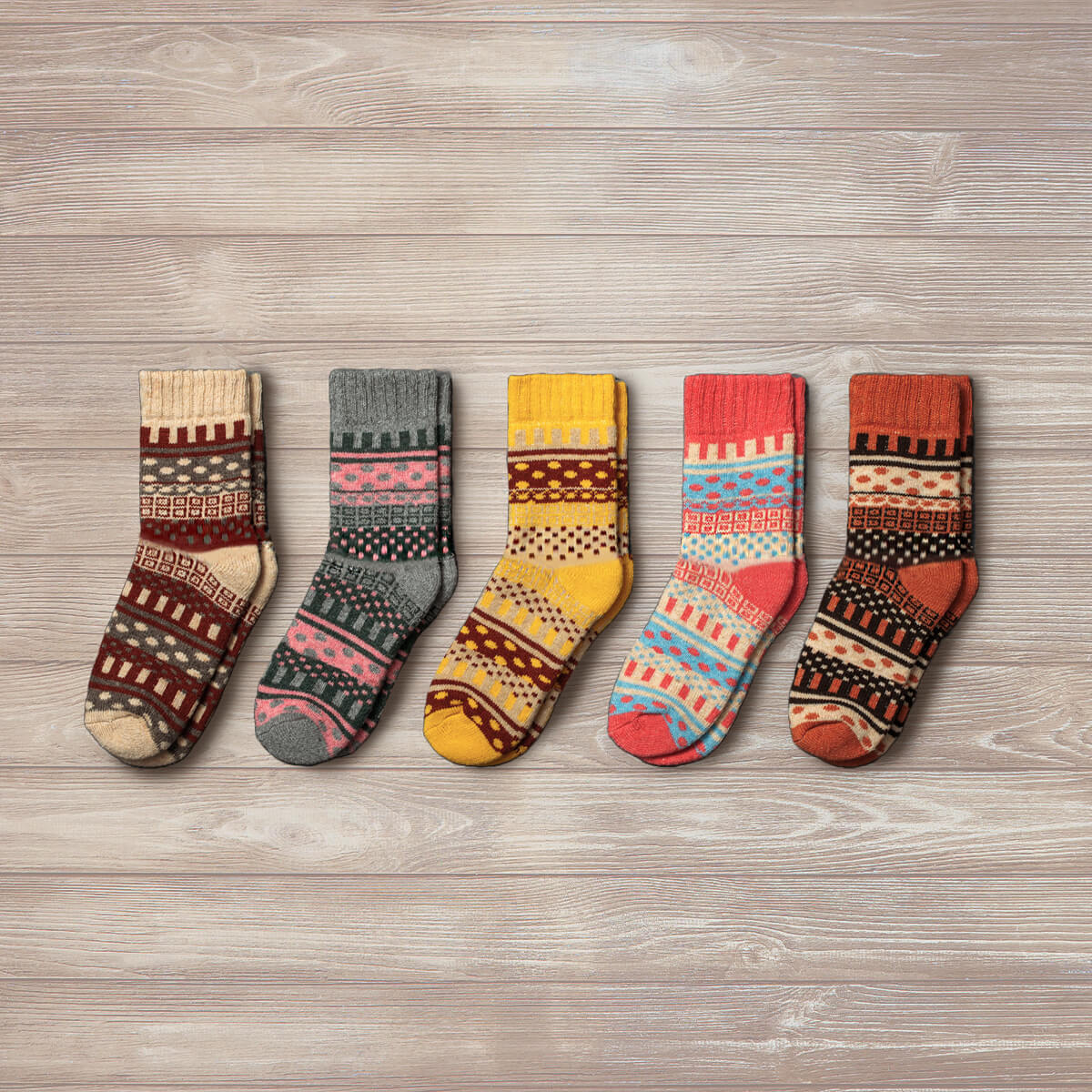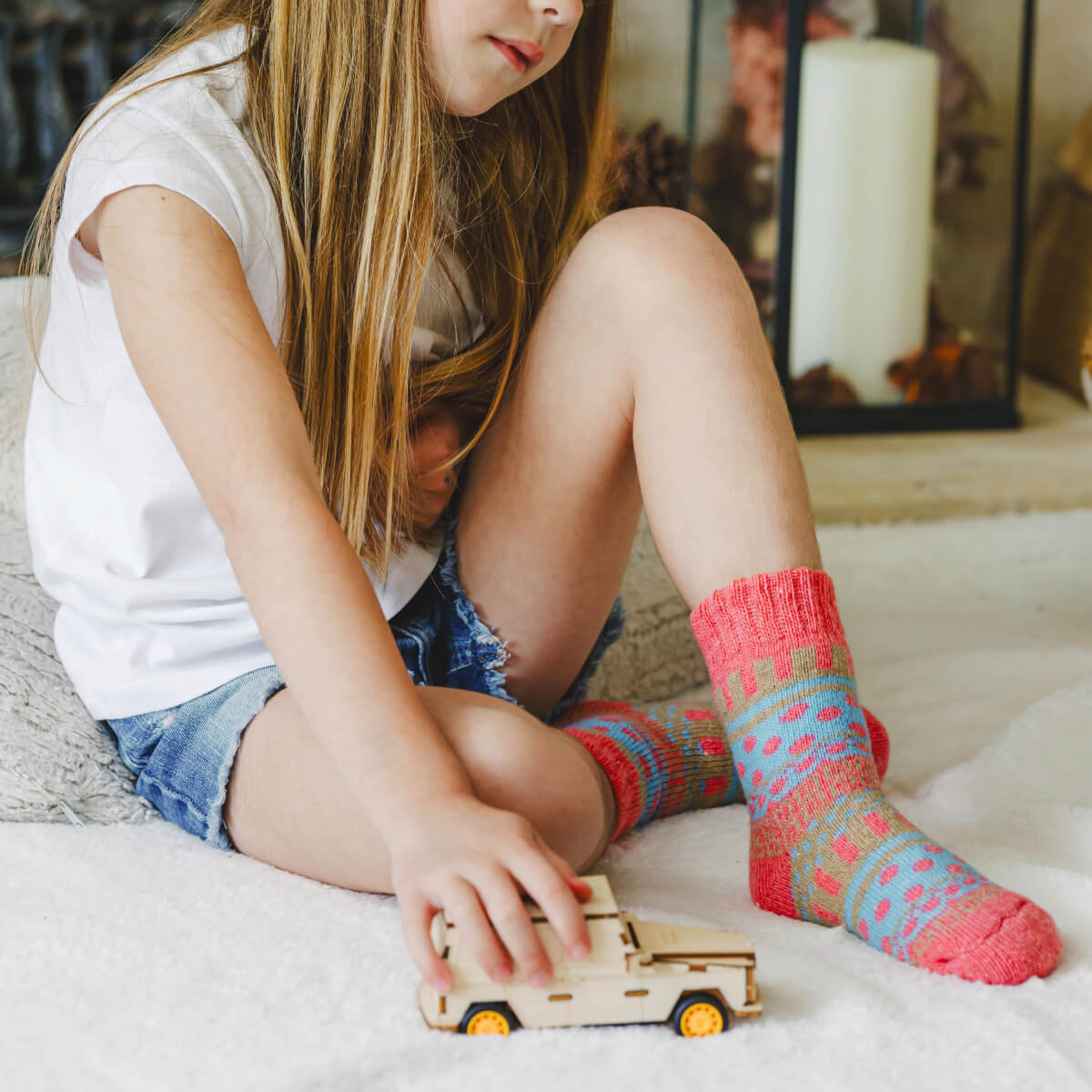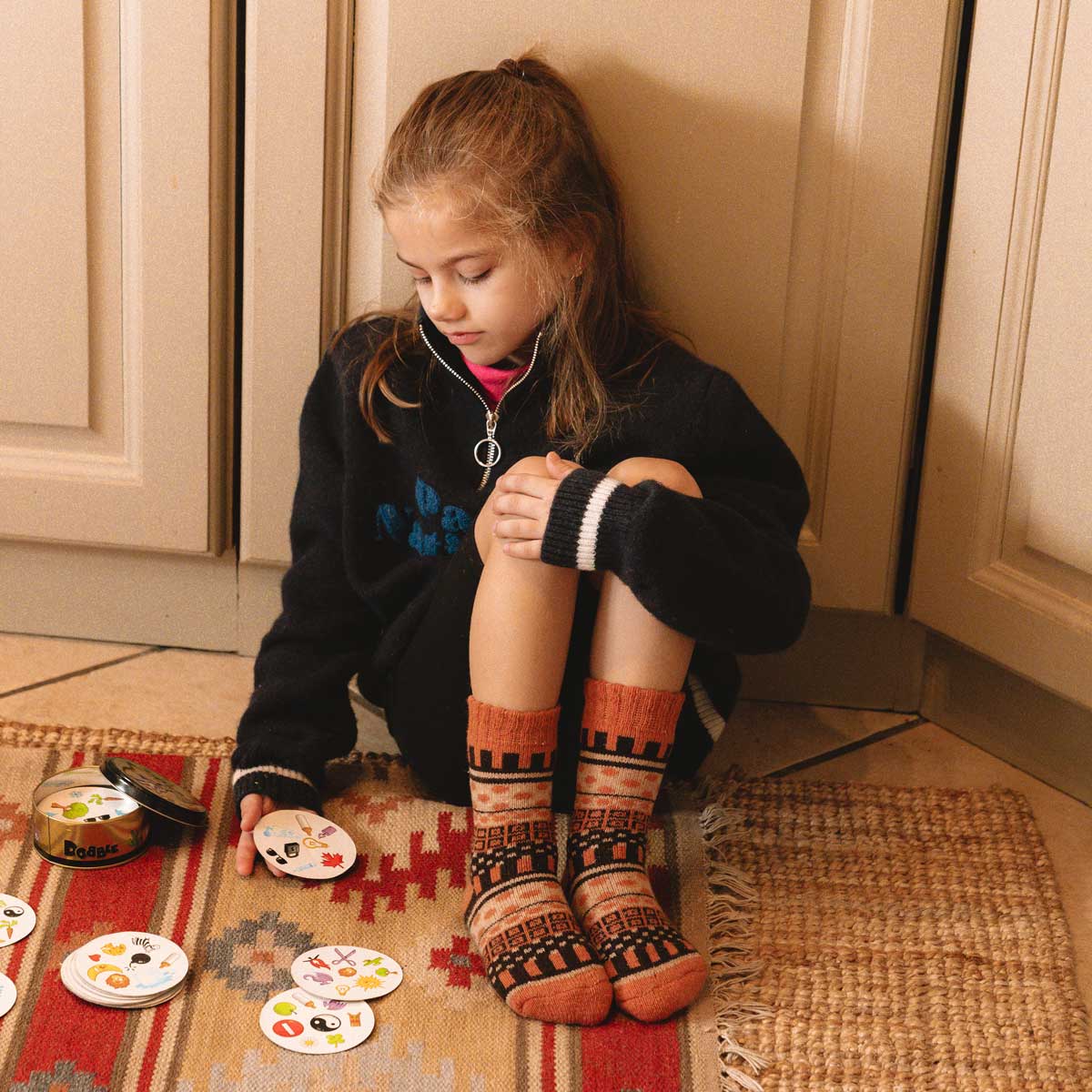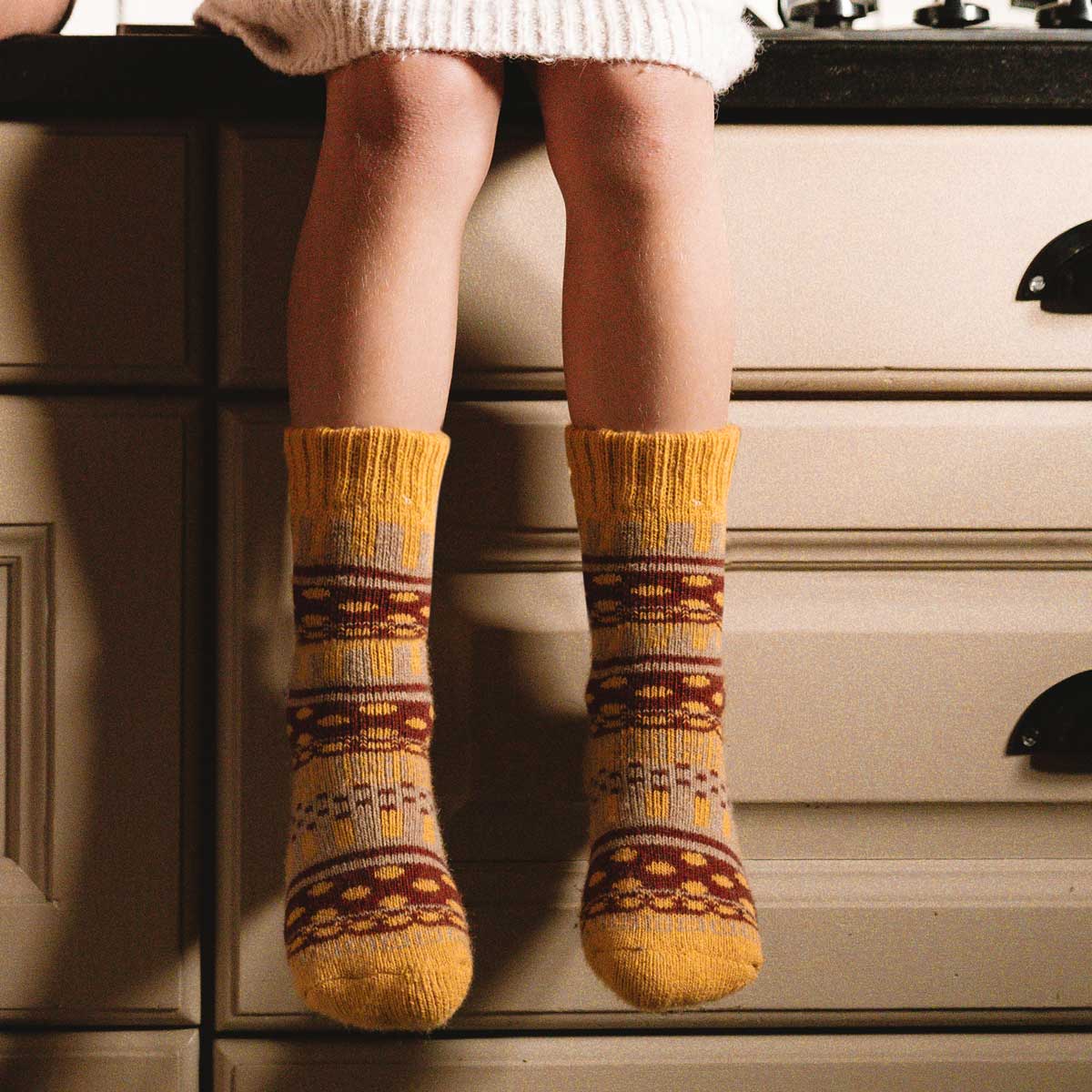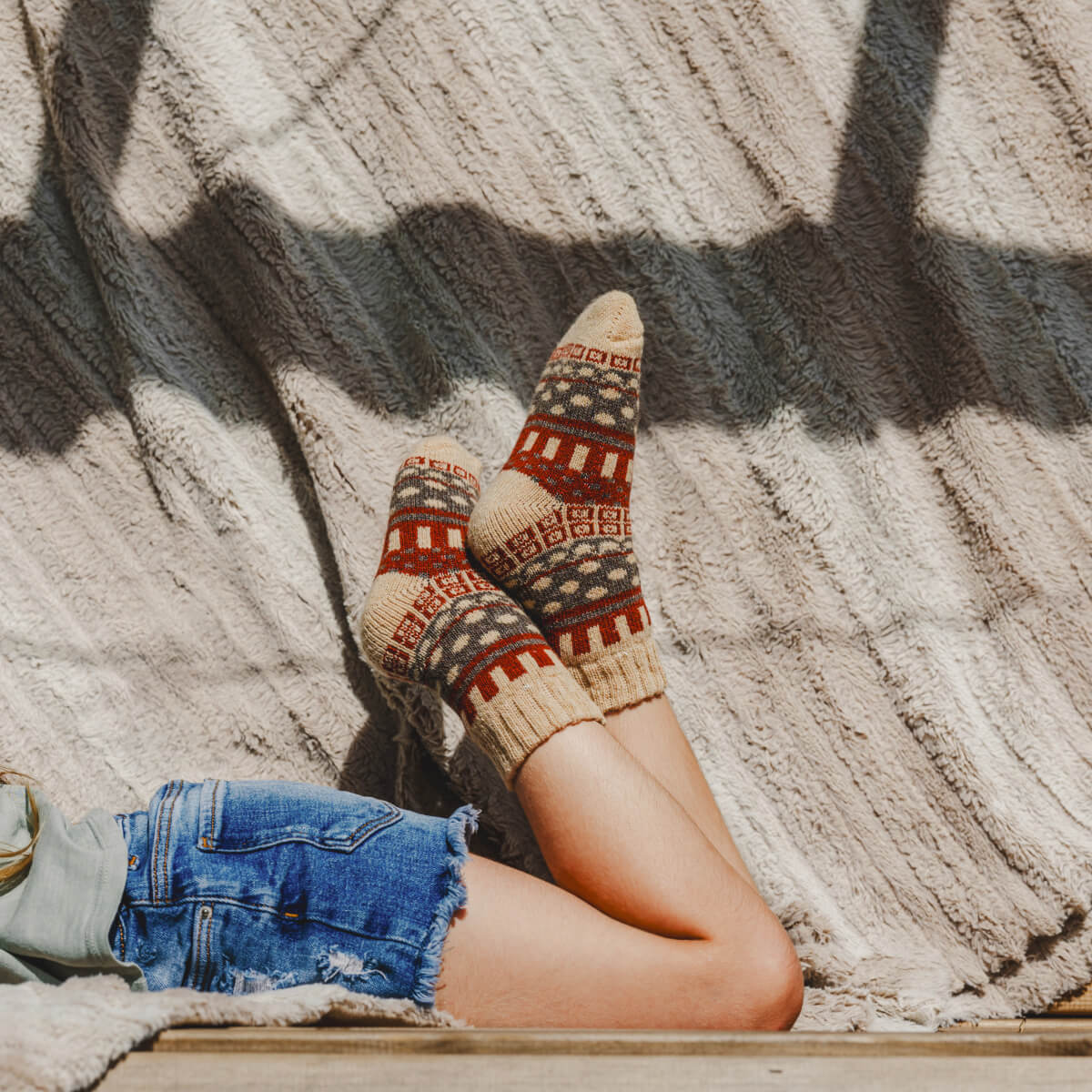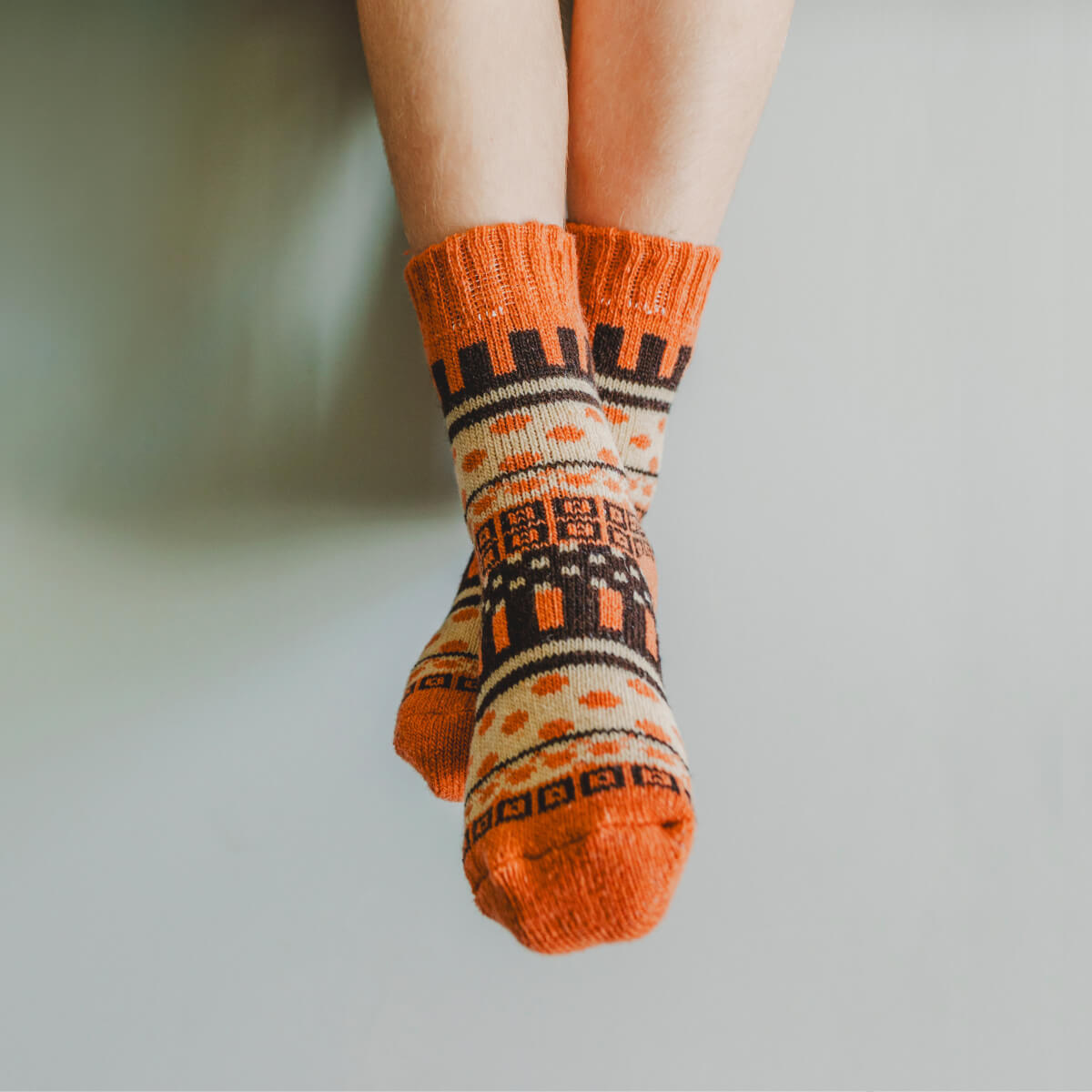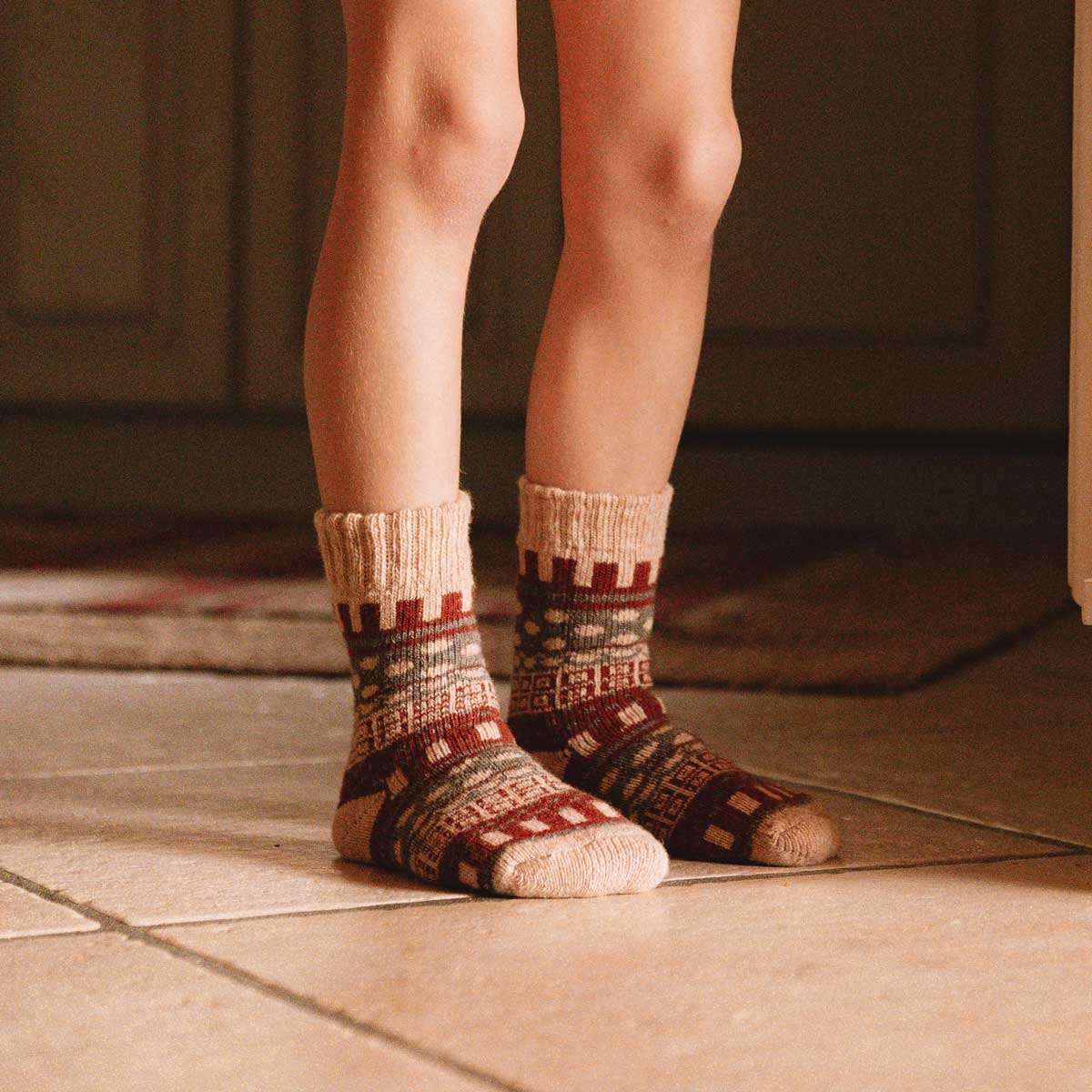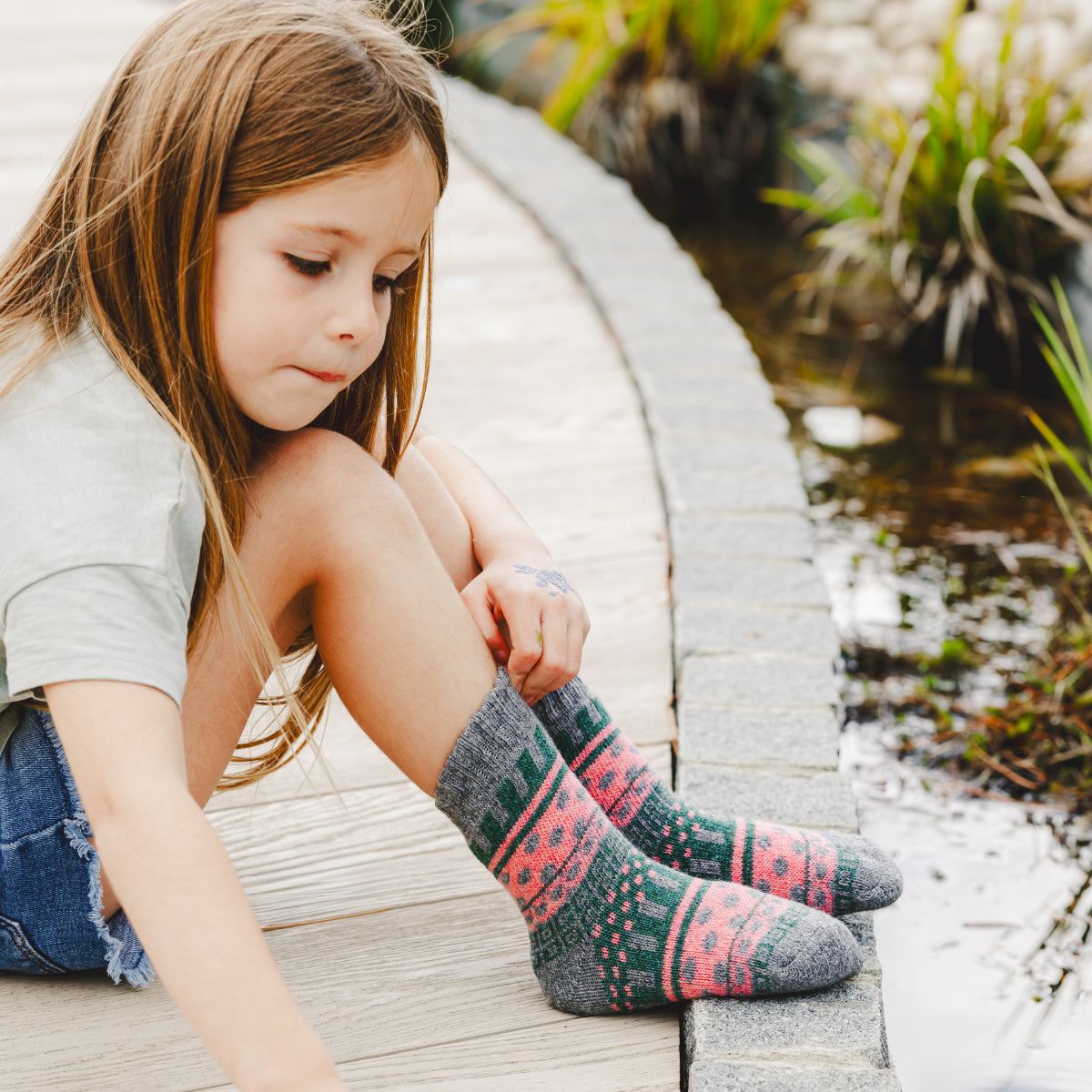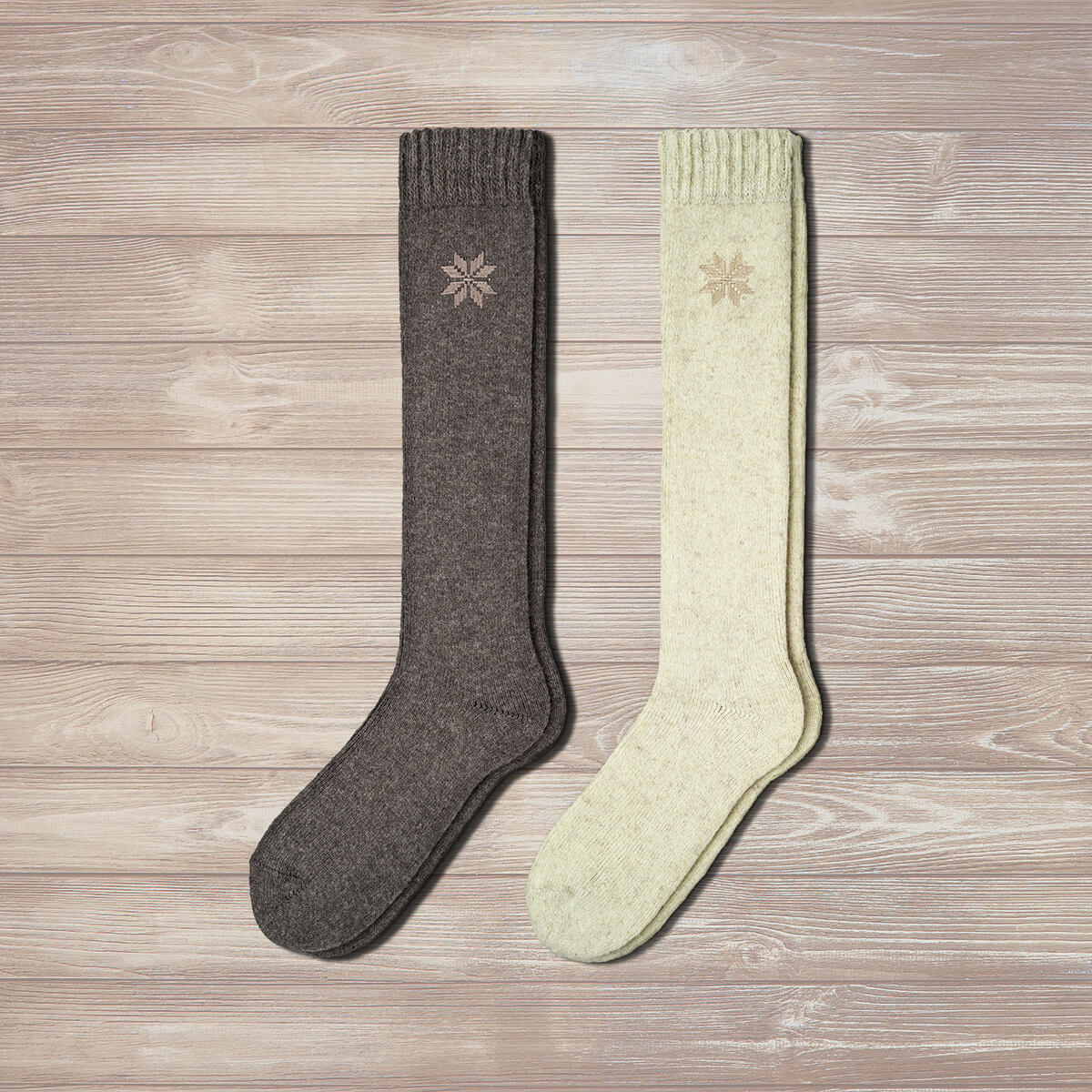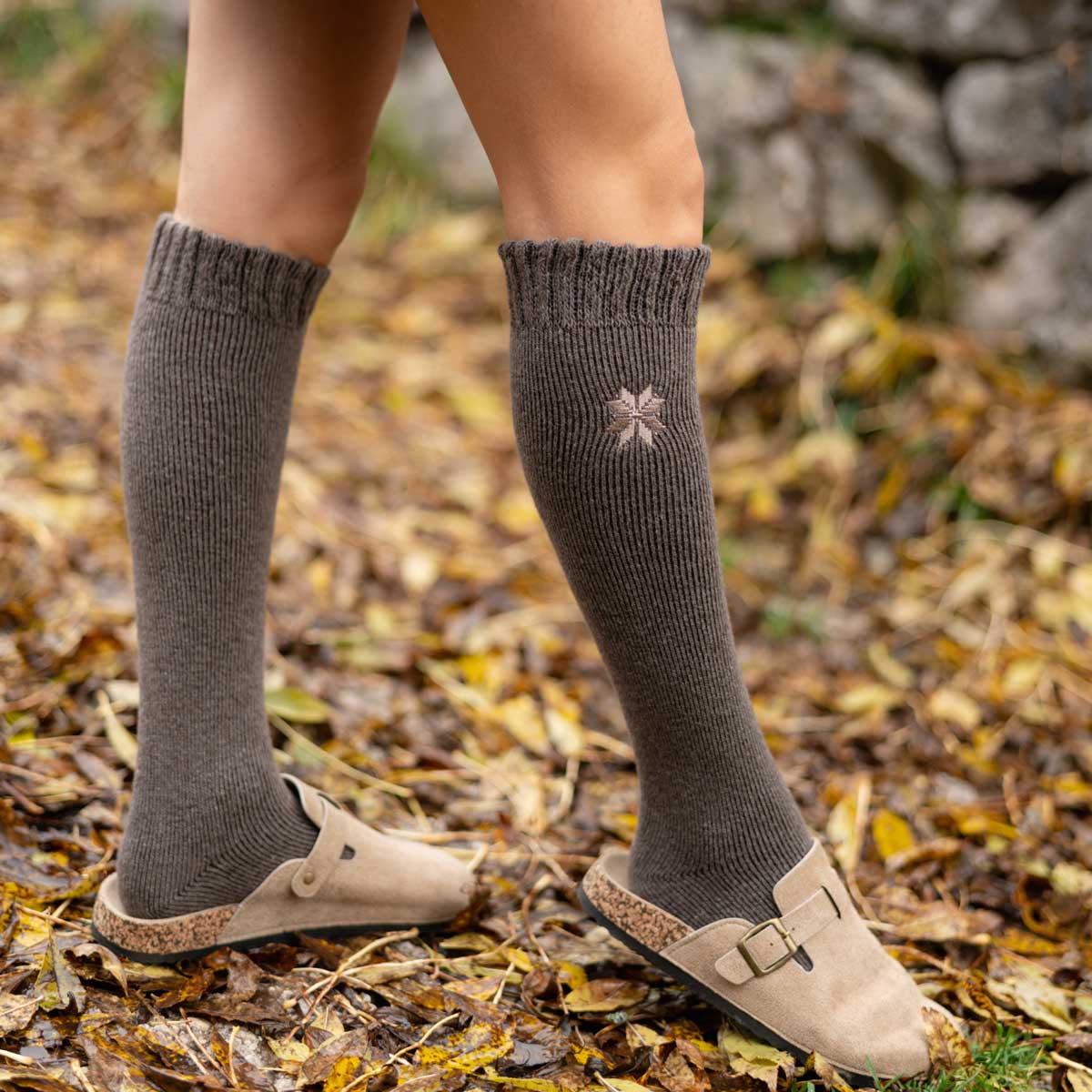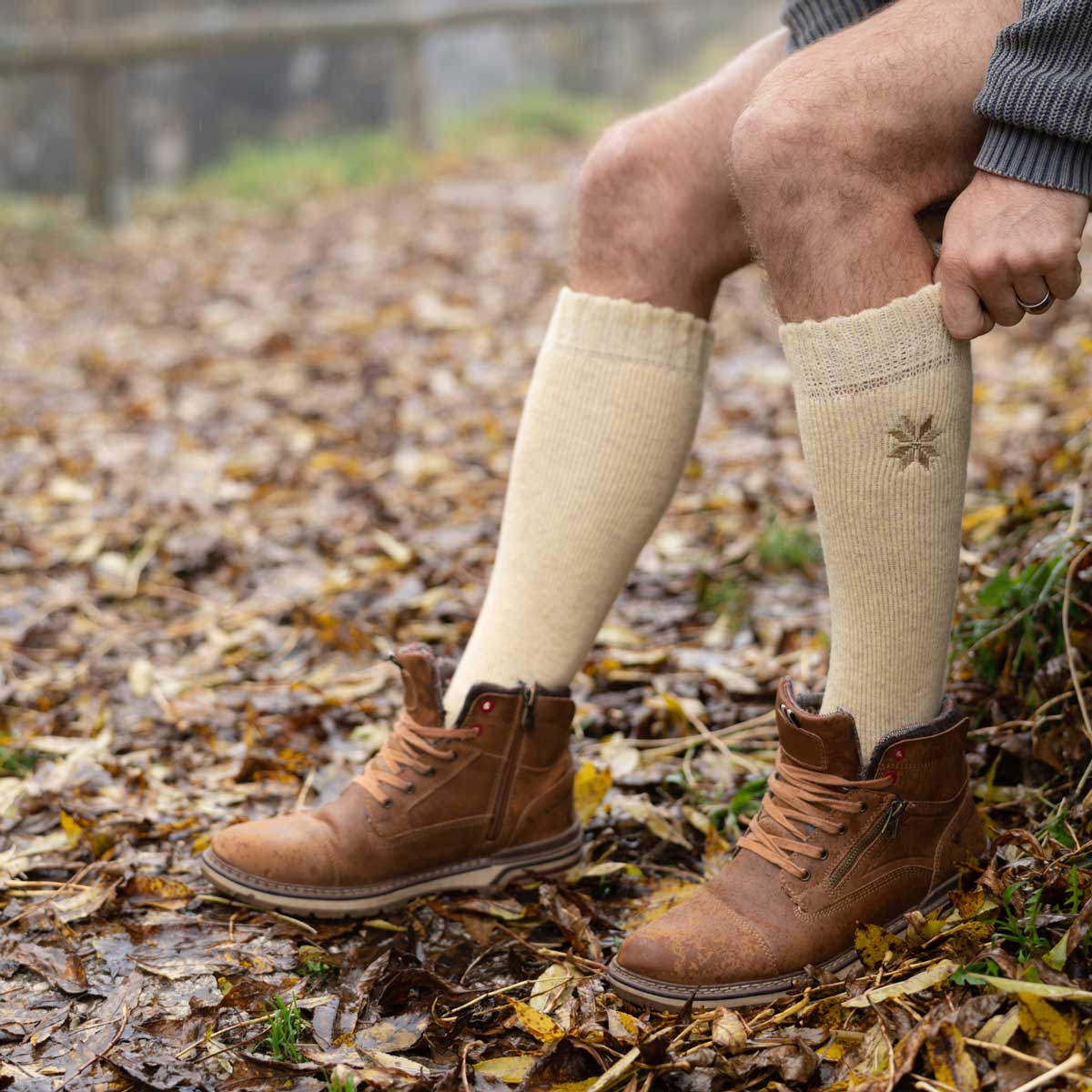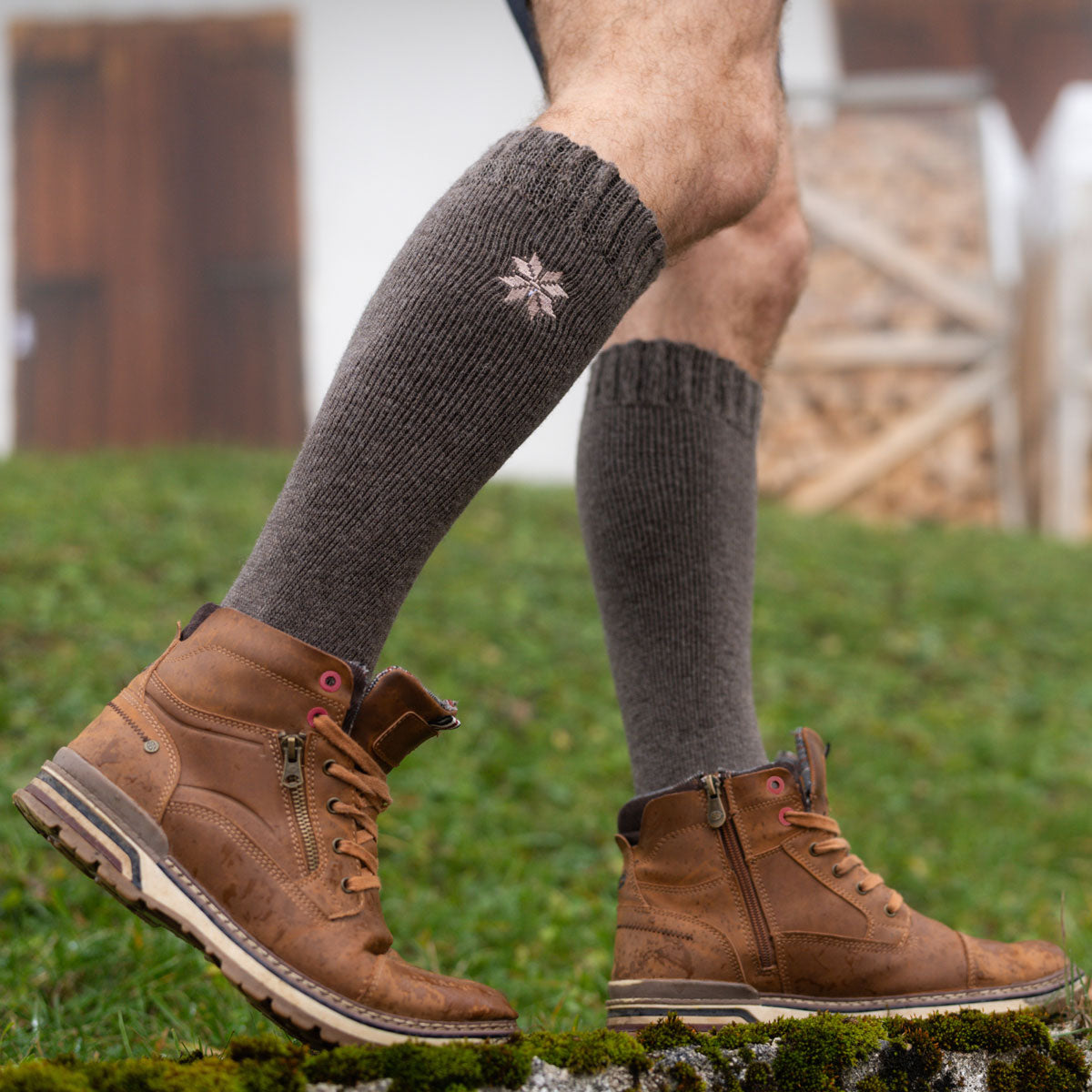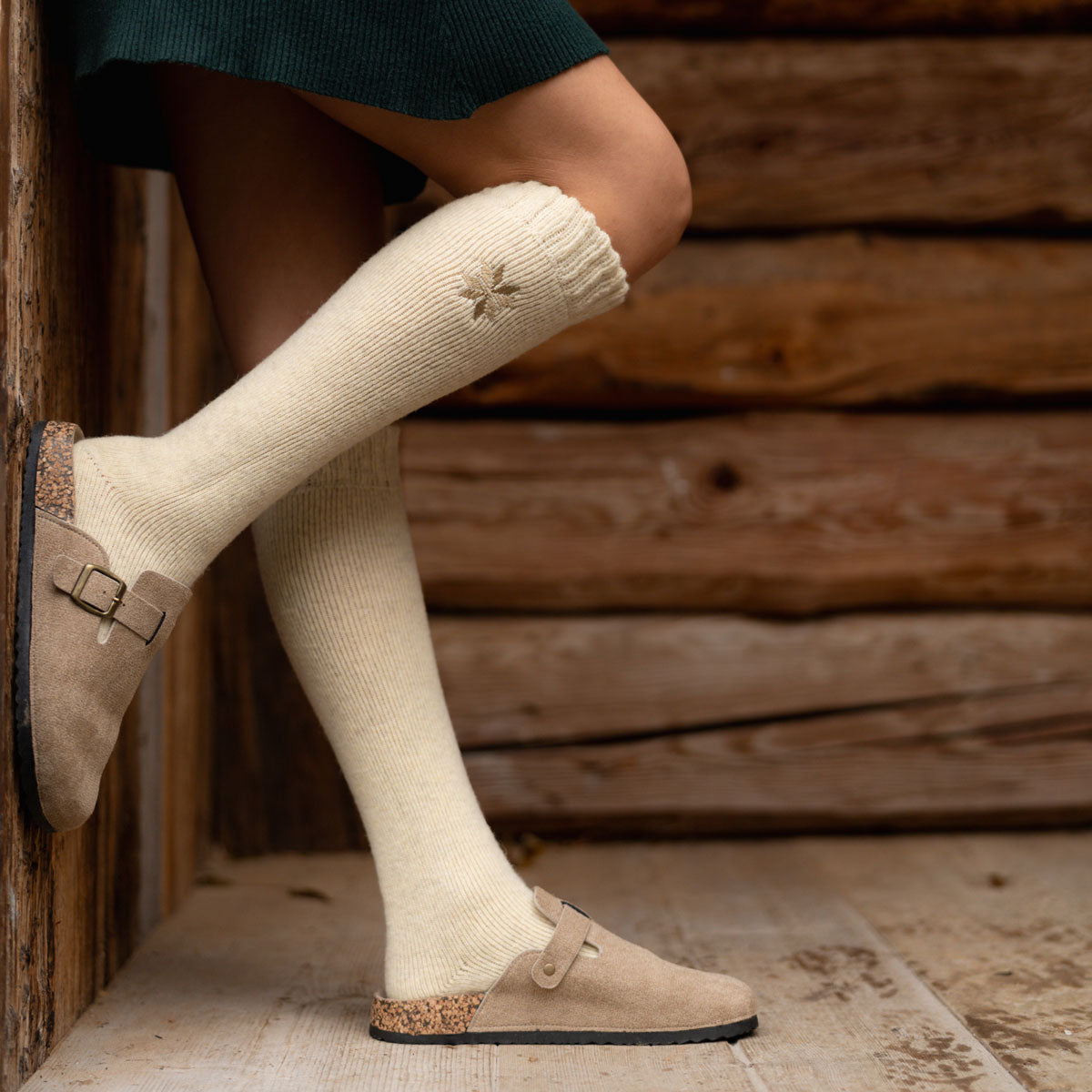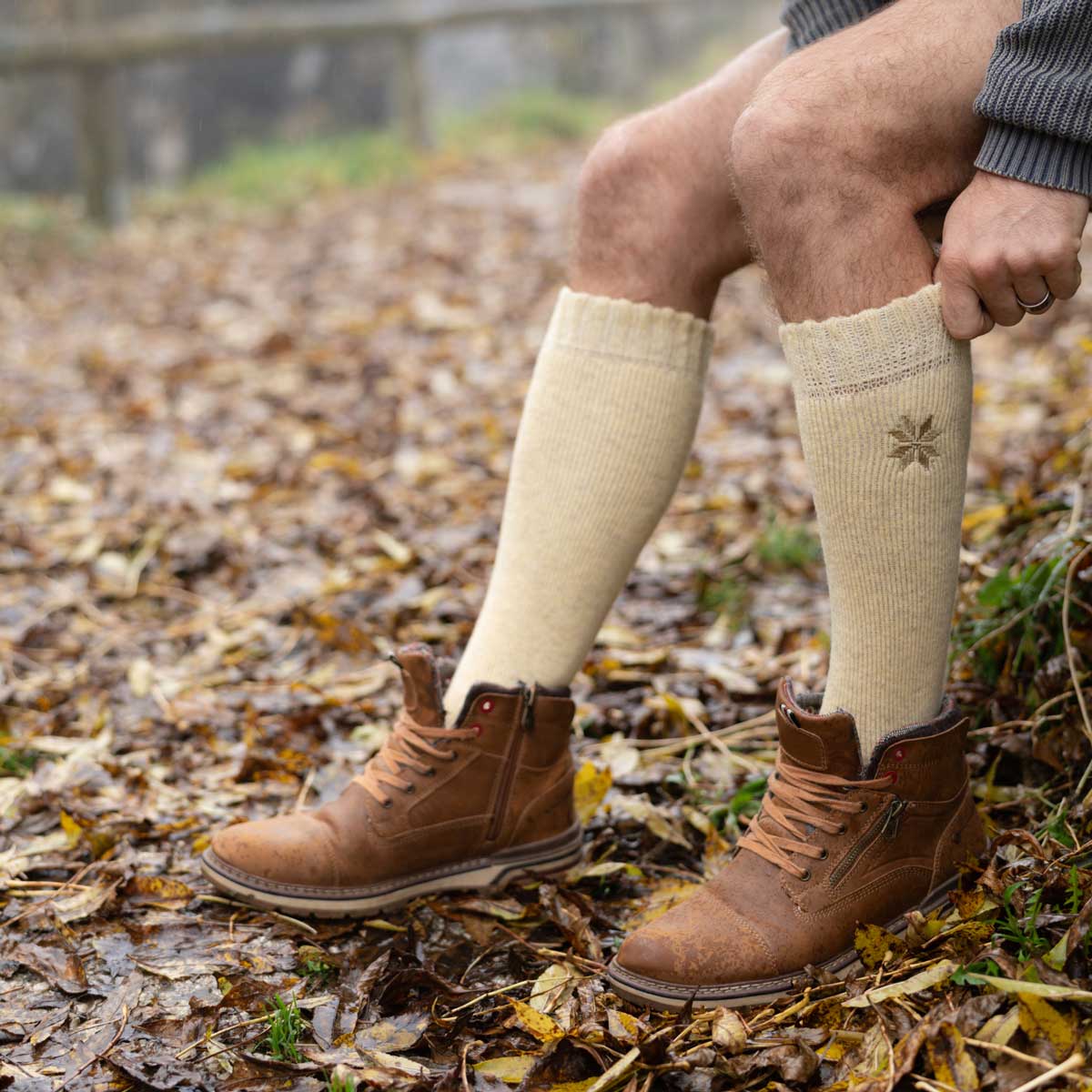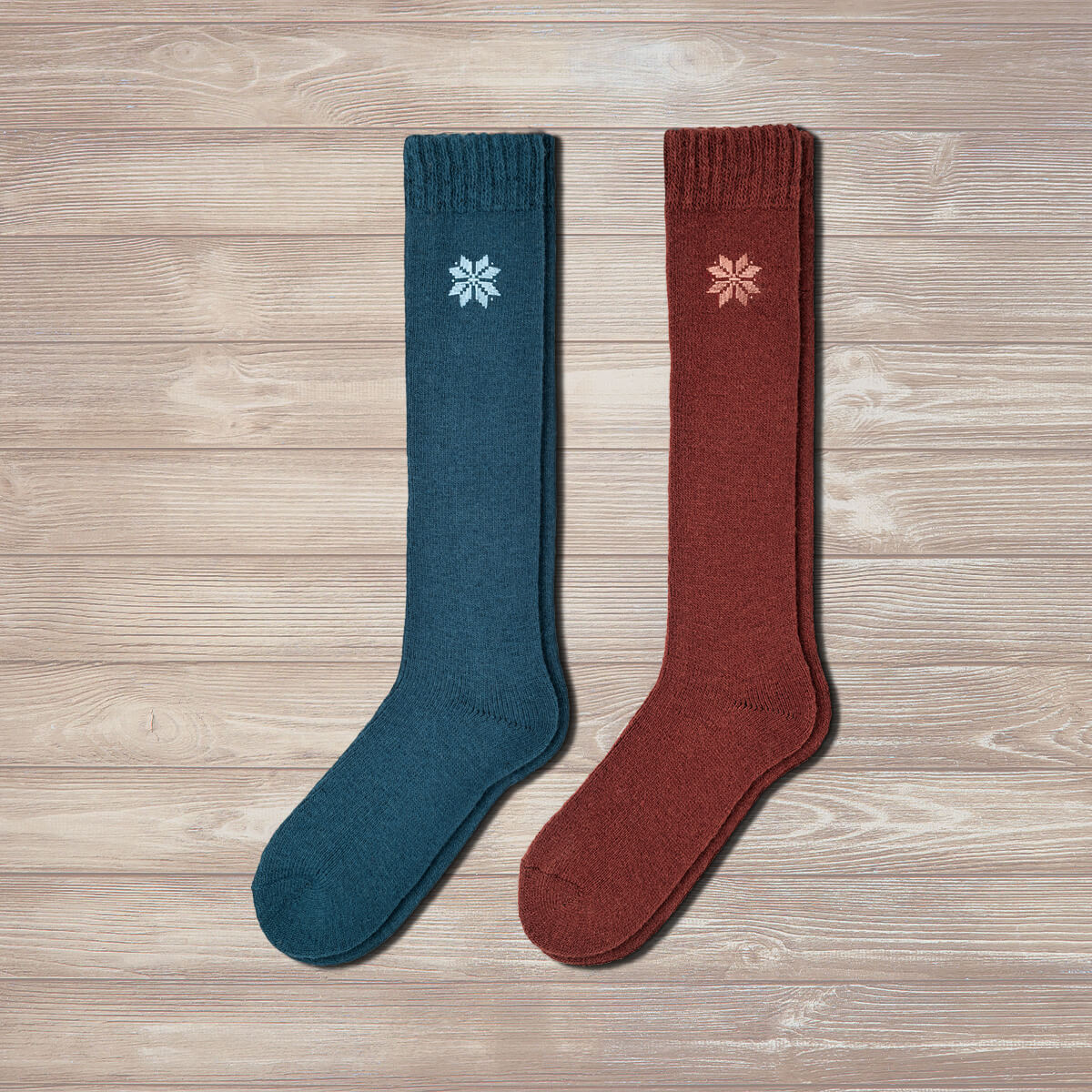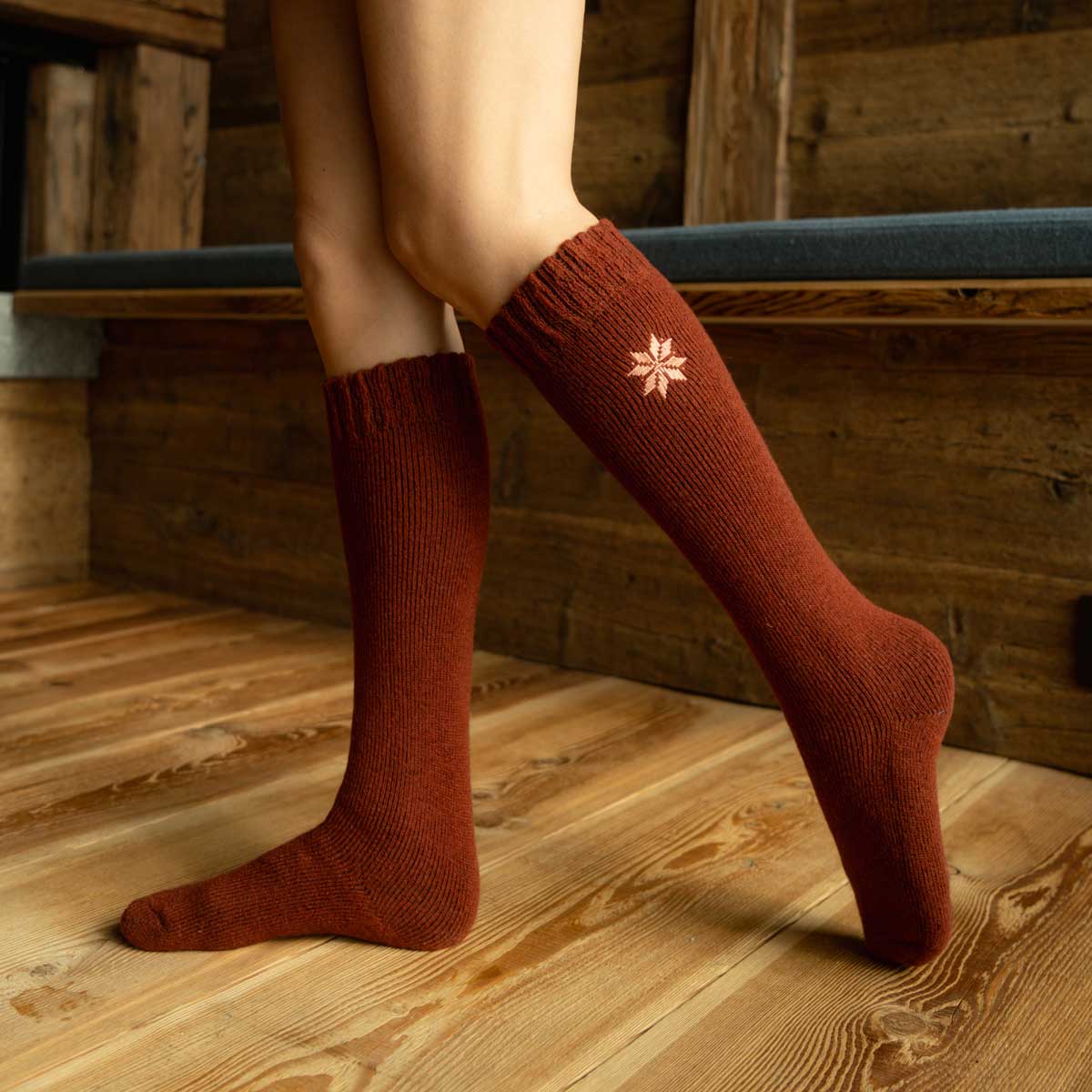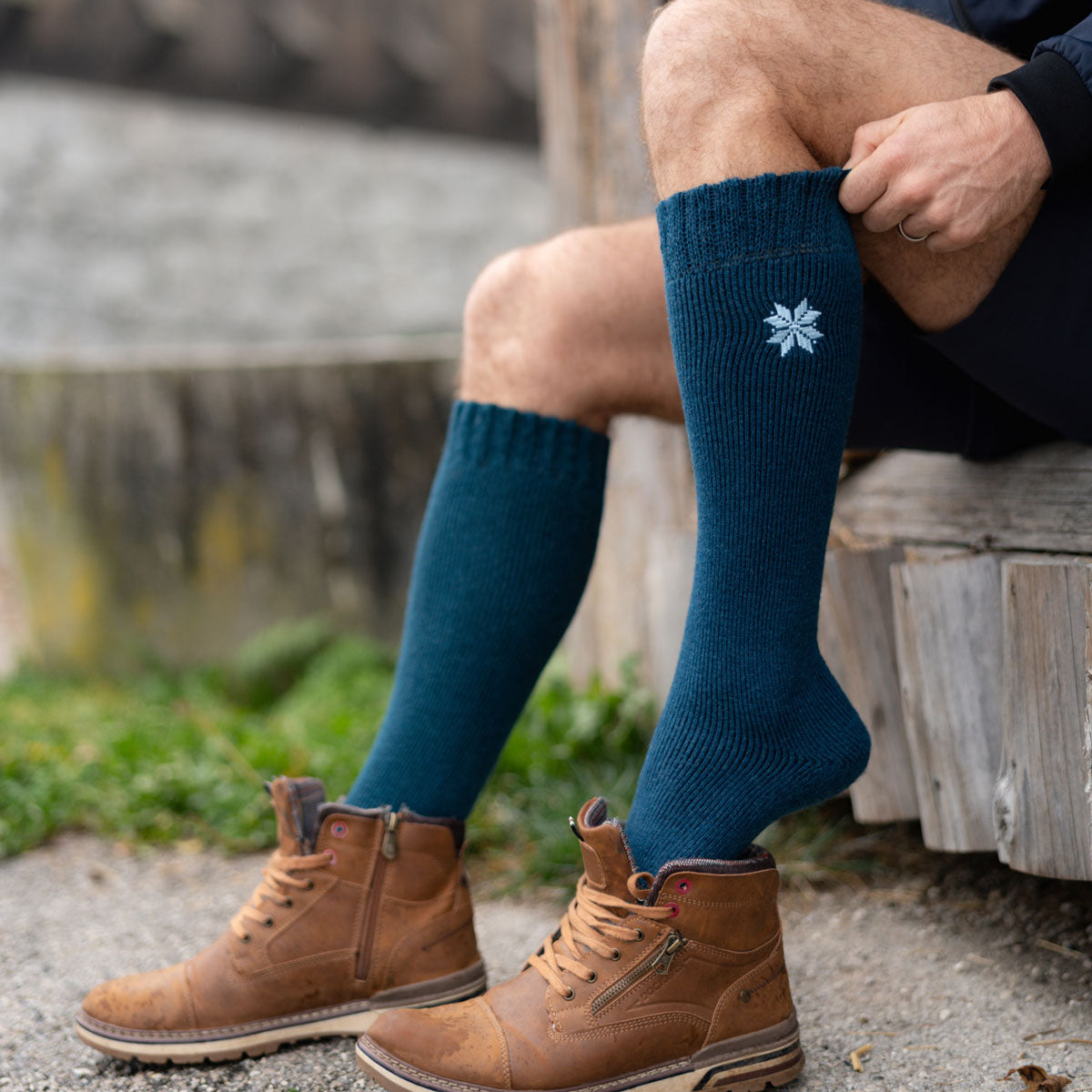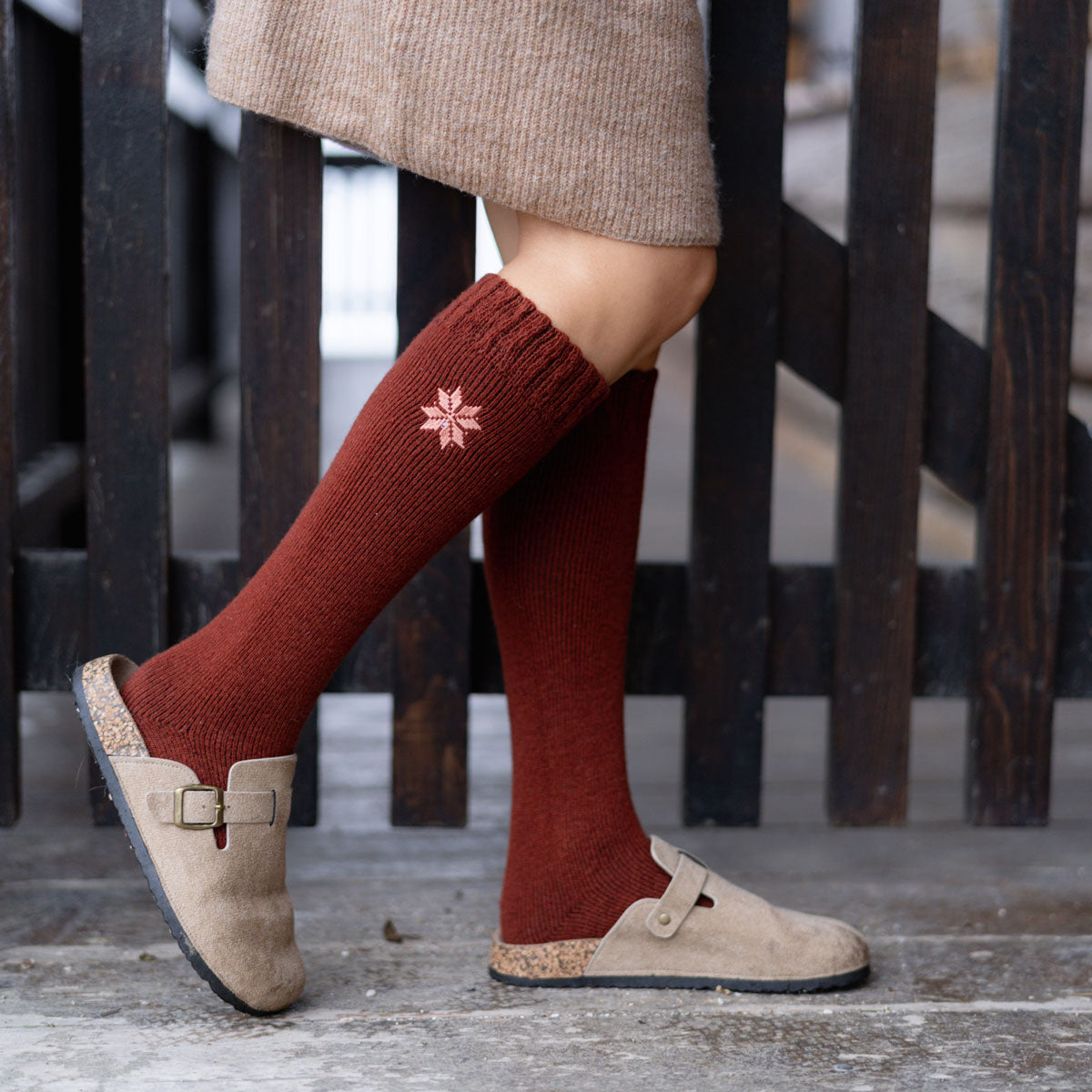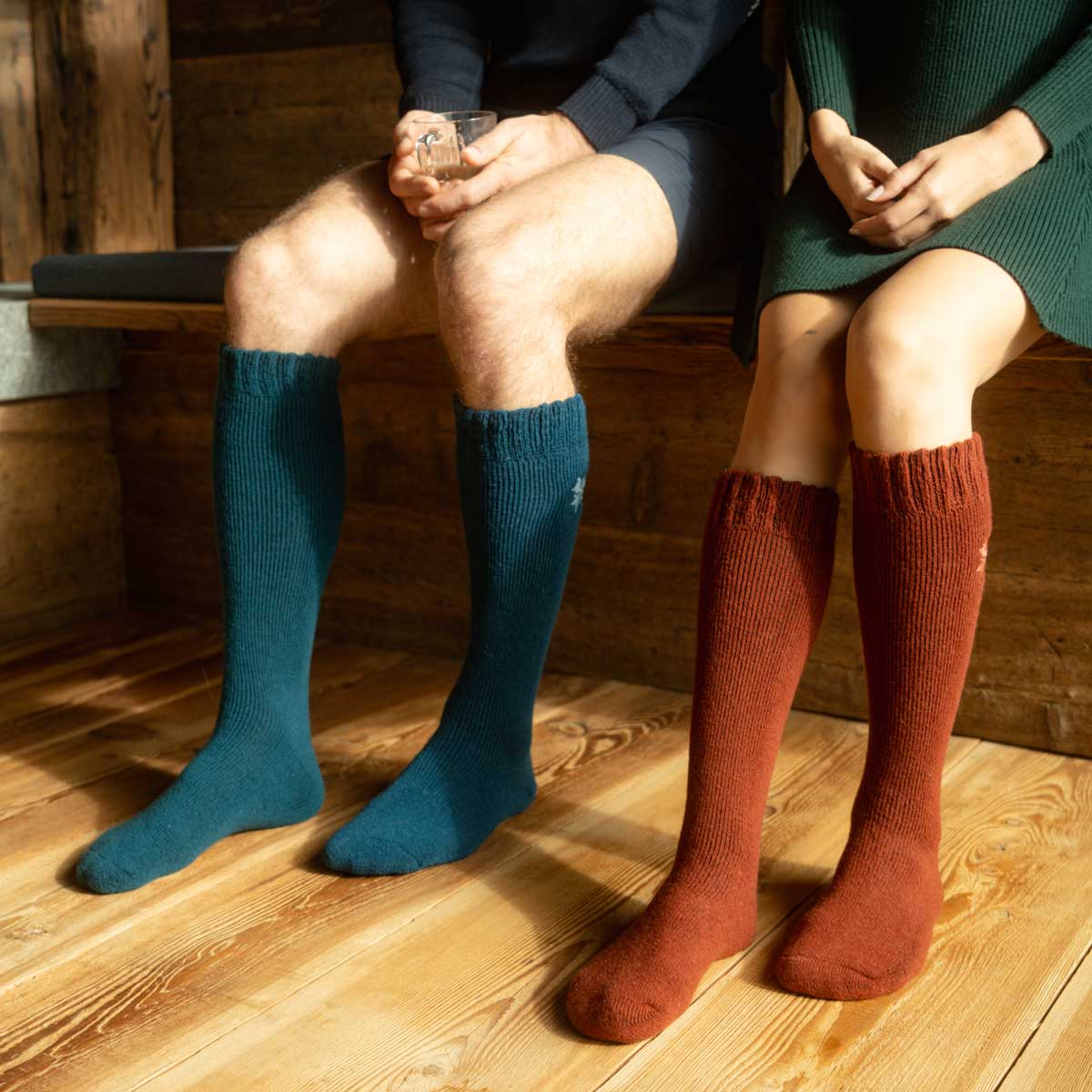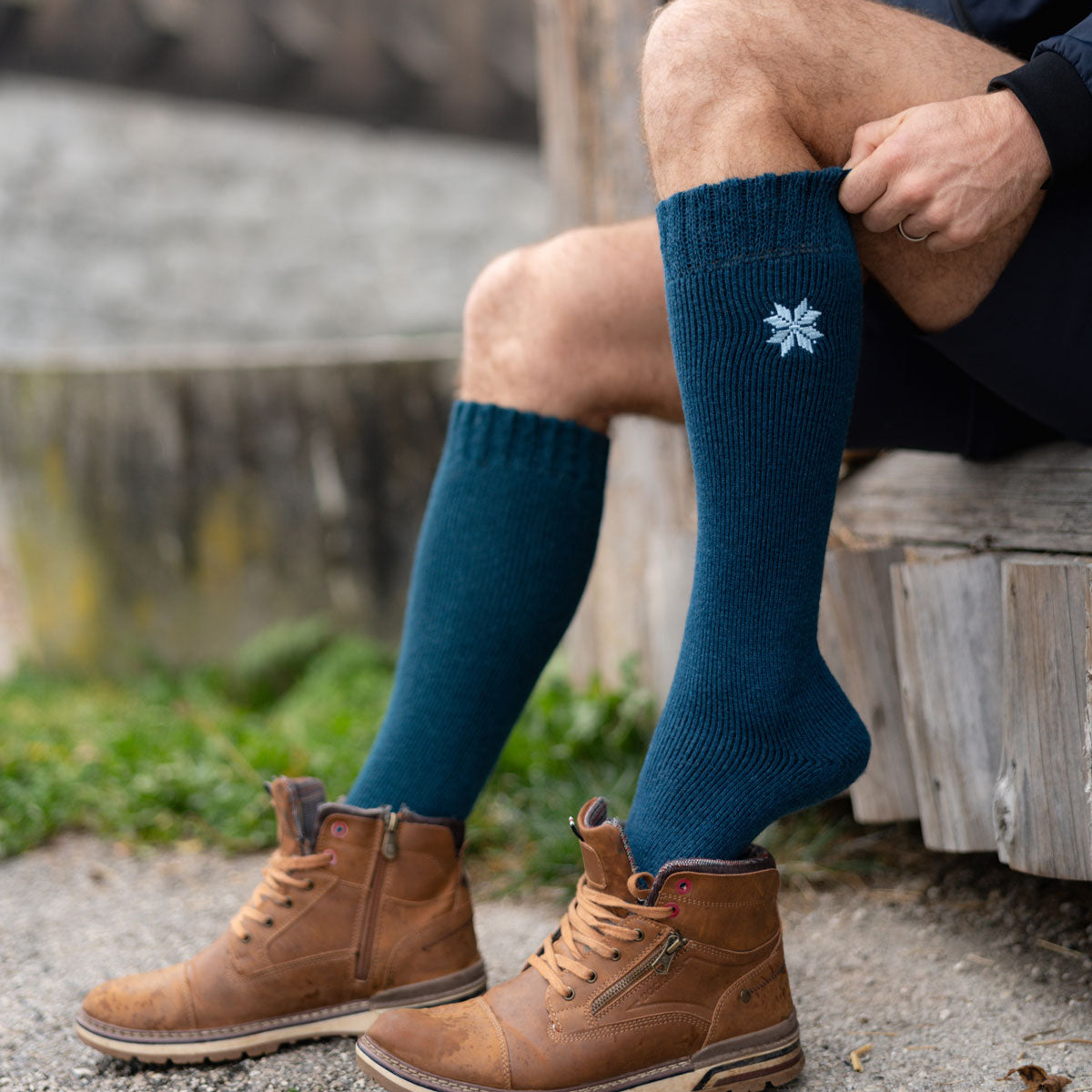Your Cart is Empty

Gear Up for Adventure: Wool Hiking Socks for Your Next Trek
9 min read
The article provides a comprehensive guide to selecting the ideal hiking socks, focusing primarily on the advantages of Merino wool hiking socks. It explains the essential features of good hiking socks, such as improving circulation, seamless construction for comfort, and moisture-wicking capabilities to prevent sweating. The article compares wool to synthetic materials, debunking myths about wool’s durability and itchiness, particularly when premium-quality Merino wool is used. Merino wool, with its fine fibers, offers softness, flexibility, and temperature regulation, making it suitable for all-season hiking. Its natural insulating properties keep feet warm in cold weather and cool in hot conditions.
Different sock heights are discussed, with each serving different hiking environments. Crew-length socks are ideal for colder seasons, while ankle socks work well in warm weather. The article recommends brands like Nordic Socks, highlighting their Activity Collection that features three sets: Adventurer, Explorer, and Traveler. These socks blend Merino wool with durable materials and are designed with features like compression areas, ventilation mesh zones, reinforced heels, and seamless toes.
The guide also includes care tips for Merino wool socks, such as washing them at low temperatures, avoiding fabric softeners, and air-drying to preserve their longevity.
Introduction
Hiking is the great equalizer - the trails are as varied as there are fitness levels. The sole issue is that there are as many equipment versions to try out.
We will help you cut the chase with the most comprehensive guide for hiking socks. Once you have a good grasp of the perfect pair for you, the rest will be easier than a beginner's trail.
What Makes a Good Hiking Sock?

Needs vary, but quality is verifiable. A good pair of hiking socks is one that prioritizes your comfort and performance. This activity can be physically demanding, especially for those who have just started out or who want to challenge themselves.
So, a completely relaxed feel is crucial. Let the strain come from braving mountaintops, not from your tortured soles.
Features of the Best Hiking Socks
You need to shop for specific characteristics to achieve the feeling that only good hiking socks can provide. Namely:
- Socks that improve circulation thanks to their snug feel and compression areas
- A comfortable step thanks to minimal seams or seamless toes
- Minimal sweating
- Temperature regulation

Comparing Wool and Synthetic Materials
This is not to give other materials a bad name. However, wool blends tend to cater to the needs of more hikers all over the world.
A myth surrounding wool is that it's itchier than its synthetic counterparts. It can, however, be a very soft material, especially if it's of premium quality like Merino.
You might also believe it's less durable than a material that withstands high washing temperatures. As long as you follow the washing and drying guidelines, you may expect to wear your woolen hiking socks for a long time. So, this fabric is more than swell, but is it ideal for hikers?
Why Merino Wool is Ideal for Hiking Socks
Since hiking is a versatile sport, you can practice during all seasons. As long as you keep it safe and comfy, of course.
A first literal step for a positive hiking experience is wearing adequate gear. And the reasons for this are multiple, more than you think. Although, of course, warming your feet in winter is a crucial pro of Merino wool, there is more to your hiking socks than this fact.
The Lesser-Known Benefits of Merino Wool
The primary benefit is that your feet will feel pampered even as you brave steep hills and mountains. We know that wool does not always have a good reputation for comfort since its coarseness is a well-known myth. A myth that is even less applicable to wool coming from Merino sheep.
Unlike traditional wool, which can feel coarse and itchy because of its thick, short fibers, Merino wool provides a much softer, more comfortable experience. Merino wool fibers are about half the thickness of regular wool, around 20 microns in diameter.
This makes them finer, more flexible, and much less likely to irritate your skin. For hiking socks, this is a godsend, as you will certainly encounter difficult terrain in your journeys. Do not make your hike session more challenging than it ought to be, choose socks that keep as comfortable as possible throughout the ordeal.
Another core benefit is that your feet will be insulated from extreme temperatures, whether we are talking about positives or negatives!
Merino wool fibers are like tiny springs, full of natural curls that create air pockets. These pockets act as insulation, trapping warmth in cold weather and allowing heat to escape when it's hot.
Think of it like the insulation in your home—it keeps you warm in the winter and cool in the summer by regulating airflow.
Additionally, Merino wool absorbs moisture (up to 30% of its dry weight) from your skin, allowing sweat to evaporate on the fabric instead of on your skin, reducing the cooling effect in colder weather.

Understanding Different Sock Heights: Crew, Ankle, and No-Show
Although Merino wool is a highly versatile materials, there is more to hiking socks than fabric. Your needs as a hiker may vary as seasons change, and that's where sock lengths come in.
Crew-length socks are a favorite among many active people. These socks above your ankle and to your lower calf. Crew socks are especially useful in fall and winter due to the added warmth and protection, but they can be worn year-round for added ankle coverage and support. They’ll be visible underneath your pants, making them a great choice if you want to showcase stylish patterns, like Nordic prints, for a standout look.
Ankle socks are ideal for hiking in warmer weather, such as late spring, summer, or early fall when the sun is still gentle. They provide enough coverage to protect your feet and ankles while allowing for more breathability.

Finally, for the hottest of days, you can choose no-show socks. As their name suggests, they will not be visible at all. They are your little secret that keeps your feet thermoregulated. Plus, your ankles will be bare and ready to feel the cool breeze.
Best Merino Wool Hiking Socks
Here are some top contenders for the title of `best Merino wool hiking socks`. They ship to North America, Australia, New Zealand, and all European countries, so you can practice your hiking hobby in multiple corners of the world.
Nordic Socks is a brand that offers top-quality socks, available both as individual pairs and in sets. While it displays a wide variety of fine materials, it has a special interest towards Merino wool blends.
The brand draws inspiration from the beauty and heritage of Nordic culture. Its goal is to create a comfortable and homey feeling for all its clients. The Danish word `hygge` encapsulated this feeling of happily belonging in a group and being cozy with your close ones.
As you know, people in the Nordic area are generally happy with their lives, enjoy tight-knit communities, and they tend to be hike enjoyers, too.
This is why Nordic Socks created the Activity Collection, dedicated to all hikers and other athletic types.
Activity Collection- Best Performance Socks For Hiking
The Activity Collection offers three vibrant sets of hiking socks, with each set consisting of two pairs:
- ADVENTURER SET
- EXPLORER SET
- TRAVELER SET
They contain 40% Merino wool, as well as other supportive materials that increase durability. That is not all. To have truly beneficial hiking socks, there are some special characteristics. Packed with innovative features and designed for maximum comfort,the Activity socks are a step above the rest.
What makes them so special?
Compression Areas
These areas enhance blood circulation, reduce muscle fatigue, and give your feet the support they need. It's like a gentle hug for your feet, ensuring you stay energized no matter how long your day gets.
Ventilation Mesh Zones
Say goodbye to sweaty feet. These slightly thinner mesh areas ensure your feet stay cool and dry, even during the most intense workouts or hottest summer days.
Reinforced Heel
The reinforced heel adds an extra layer of durability and support, preventing wear and tear in high-stress areas. Whether you're hiking up a mountain or just strolling through the park, Activity socks provide superior padding and support.
Seamless Toe
Experience the ultimate in comfort with our seamless toe construction. This feature prevents blisters and ensures a smooth, comfortable fit so you can focus on your activities without any distractions.
Ankle and Arch Support
Perfect for running, hiking, or just walking around town, this support helps to prevent injuries and keeps you on your feet all day long.
Stay-Put Cuffs
All socks in the Activity Collection feature stay-put cuffs at the top to keep them securely in place and prevent slipping, even during the most intense activities.
Smart Cushion
Terry loops provide cushioning, create air pockets for insulation, and wick away moisture. We've placed them in high-stress areas to add extra comfort and support for your soles, ankles, and Achilles.
Moreover, this collection is available in regular and low-cut lengths. You can also opt for thinner or thicker versions to better adjust to the season and other conditions of your hike.
How to Care for Your Merino Wool Hiking Socks
- Temperature: Wash in cold or lukewarm water, ideally between 30-40°C (86-104°F).
- Washing Cycle: Use a gentle or delicate cycle to prevent damage to the fibers.
- Avoid: Do not use bleach or fabric softeners, as they can break down the wool’s natural properties.
- Drying: Air dry only. Avoid tumble drying to preserve the fabric’s quality and prevent shrinkage.

Some people might shy away from Merino wool because it seems difficult to care for. Even so, your woolen hiking socks are easier to handle than you may have imagined. Washing should be done with care, indeed, but as long as you opt for temperatures up to 40 degrees Celsius (104 degrees Fahrenheit), this process will not be a hassle at all. To be absolutely safe, Nordic Socks recommend going below the 30-degree mark.
Another suggestion is to choose a gentle washing cycle dedicated to fragile pieces of clothing. There are some restrictions concerning detergent, too. Fabric softeners will often alter the shape of your hiking socks. Furthermore, bleach, which is a pretty harsh detergent as-is, is not recommended for these sock pairs either. Washing by hand is advisable as long as you gently handle these pieces of clothing.
Drying is the second half of this process. It's recommended to hang the socks out to dry on an indoor rack. If you need to dry your laundry outdoors, it's okay, as long as you avoid keeping the woolen socks in direct sunlight. The sun tends to discolor and affect the material.
Something absolutely forbidden for your hiking socks' wellbeing is the use of tumble-drying. Although having a dryer is often convenient, wool and this machine do not really mix, especially for fine pieces of clothing like these ones.
Extending the Life of Your Hiking Socks
Besides keeping a relatively low washing temperature or cleaning your socks by hand, you should avoid altering the hiking socks' shape. Even if you feel inclined, do not wring them by hand. They risk changing shape permanently.
Once your socks are dry, fold them gently. If they need ironing, use low temperatures only. Some irons have a specific wool setting to make it easier.
If your hiking socks shrink, you can stretch them back into shape by gently pulling them after hand washing.
Conclusion
With proper care, you can take your hiking socks for numerous adventures throughout the years. Merino wool is an ideal material to go for hikes - its temperature regulation qualities are top-notch, as is its power to absorb moisture.
The Activity Collection offers the perfect hiking socks, but they're also great for any physical activity. These performance hiking socks adapt to varying intensity levels and environments. It's possible to choose between thick and thin hiking socks from this collection, too. This way, you will make the most of Merino wool's properties.

FREQUENTLY ASKED QUESTIONS
What kind of socks to wear with trekking shoes?
When wearing trekking shoes, it's important to choose socks that provide comfort, support, and moisture management. Here’s what to look for:
- Merino Wool or Wool Blends: These socks are ideal for trekking due to their excellent moisture-wicking, breathability, and temperature-regulating properties.
- Cushioned Socks: Look for socks with added cushioning in high-impact areas like the heels and toes to provide comfort and reduce friction.
- Crew-Length or Mid-Calf Socks:These socks provide enough coverage to protect your ankles and lower legs from rubbing against your trekking shoes.
- Compression or Performance Socks: For longer hikes, consider socks with compression features to improve circulation and reduce fatigue.
- Seamless Construction: Seamless socks help prevent blisters by reducing friction in areas where seams can rub against the skin.
Should hiking socks be thick or thin?
Whether hiking socks should be thick or thin really depends on the conditions and your personal comfort.
Thick socks are great for colder weather or if you need extra cushioning on long hikes. They provide warmth and help prevent blisters by reducing friction. Plus, they’re perfect for high-impact areas like the heels and toes.
On the other hand, thin socks are ideal for warmer weather or shorter hikes. They offer breathability and keep your feet cool, while still giving you enough protection and moisture-wicking to stay comfortable.
In the end, it’s all about choosing what feels right for your feet and the conditions you’re hiking in.
Get Exclusive offers
Join our email list and get exclusive offers and 10% off on first order.
Recent Articles
-
 Nordic Socks for Every Activity April 10, 2025
Nordic Socks for Every Activity April 10, 2025 -
 What are the best cotton socks? February 18, 2025
What are the best cotton socks? February 18, 2025 -
 The Cultural Inspiration Behind Our Sock Designs December 03, 2024
The Cultural Inspiration Behind Our Sock Designs December 03, 2024 -
 What Should You Look For When Buying Hiking Socks? November 12, 2024
What Should You Look For When Buying Hiking Socks? November 12, 2024 -
 Guide to Keeping Your Feet Toasty: The Best Socks for Cold Weather October 22, 2024
Guide to Keeping Your Feet Toasty: The Best Socks for Cold Weather October 22, 2024
Related Products
Enjoying this content?
Sign up to get notification about new articles, special offers and new products.
Knee High Socks
NEWS & UPDATES
Get the newsletter to receive direct information about offers and new products.
Where are we shipping to?
Purchase from your country’s website.
It’s the fastest way to pamper your feet with comfy socks.
other countries
English
